The small business marketing industry: Let the buyer beware!
As a small business marketing consultant who’s consulted for almost a decade, I have observed one key reality—most marketing agencies that target small businesses aren’t worth hiring. This post will give small businesses a checklist of 9 red flags to watch for when you’re evaluating a marketing agency.
Related: A 5-step guide to success on Small Business Saturday
Behind the scenes of small business marketing companies
The first thing to understand about small business marketing companies is that they don’t make much money on a single client. The less a company charges for their services, the more likely it is that that company isn’t providing you any value at all. If you are paying less than $1000/month to someone who’s not giving you a discount (like a friend or relative), chances are that their business basically consists of collecting checks. This reasoning can be explained by simple economics.
A consultant who knows a lot about marketing might expect to get $150/hr. So, if you’re paying $300/month to a marketing agency for their services, you shouldn’t expect to get more than a couple hours of work. Some of these companies get around this by hiring employees at the rate of $20/hr, and then charging the customer $60/hr while pocketing the difference.

Don’t let a strong handshake fool you into making bad business decisions.Photo credit: Flazingo Photos
That means the customer is paying for (but not receiving!) an expert level of service. An employee that can be paid $20/hr is probably right out of college. They’re unlikely to know much about SEO, which is crucial for many small businesses. What this employee can do is write is a few articles a month and provide a little bit of link building. They can be expected to handle around 20 clients/month, after factoring in bathroom breaks, client communication, etc.
A company like this is probably mediocre at marketing, since they’re managing employees at low monthly margins. Or, they’re evil geniuses who jack the margins sky-high by only assigning employees to work on your account at key points in the relationship.
Neither of these options is good for you. But don’t worry; these 9 tips will help you avoid an unprofitable relationship with a small business marketing agency.
1. Check out their design skills
When evaluating potential small business marketing companies, one warning sign is outdated website design. Web pages that look like they were created 5 years ago are a sign that the company hasn’t kept up with the latest practices. They also signal that the company lacks an in-house designer.
What that means for you is 1) the company clearly doesn’t understand the importance of visual appeal, and 2) the content you’re paying for won’t look good today, much less in the coming years. If you’re not sure about the agency’s design skills, just ask. Any competent agency will gladly display examples of their recent work to help win your business.
2. Insist on up-to-date technology
How a website is designed and implemented is more important than ever. In particular, a marketing company that builds mobile sites on a separate domain puts your mobile site in the SEO graveyard. If the company shows you a site that they built, check it out on your phone. The site shouldn’t look like a smaller version of the desktop website. All websites need to be responsive, or in other words, look and function well at the same web address, on any device. Google wants your site to be responsive and is less likely to show your search results on mobile if it isn’t. Considering how many local searches happen on mobile, you can’t afford to make this mistake.

Vintage technology looks nifty, but it doesn’t work so well on your iPhone.
3. Stay away from restrictive contracts
You’re hiring a marketing company, not signing up for cable. While contracts are important for protecting both the client and the provider, a good marketing company won’t try to lock you into a contract that doesn’t meet your needs. Many contracts will create a relationship that is longer or more restrictive than necessary. Plus, a company that has you locked into a contract may not be as diligent about impressing you with their results. You can expect a bad marketing company to really pick up their efforts about ten months into a one-year contract in the hopes that they can snag you for another year.
4. Always read the fine print
Avoid companies that quote a fixed monthly cost without getting specific about the marketing services they’ll be providing. If you aren’t quite sure what they are doing, they aren’t doing much. It pays to do your homework. It also pays to know which services you need. If you’re unsure, try asking these questions of the company:
- How often will you be adding new content to my website?
- Will you provide detailed link building reports?
- How do you plan to increase my citation count? (see #8)
Add a few more questions to this list, and you’ll be well on your way to scaring off bad marketing companies.

Don’t just fold your contract into pretty shapes—read the darn thing!
5. Search for reviews
Be sure to look up reviews on the company you’re considering. Small business marketing companies usually aren’t on Yelp, so try searching their business’s name on Google. You can usually find someone commenting about the company in a forum, or you may be able to view the company’s participation in a conference.
But do keep in mind that people who had a negative experience are more likely to complain than those who had a great experience. If you see one negative review, consider bringing it up with the company. If you see several negative reviews, just move on. One last note here: be equally skeptical of a company with overwhelmingly good reviews. They are probably offering an incentive for clients to review them, or simply paying for fake reviews.
6. Go with a local company first
It’s important that the company you are working with is local. Don’t hire a firm that doesn’t allow you to meet someone face to face. There are certainly good companies in other locations, but the squeaky wheel (that happens to be local) really does get the grease. As a consultant, I’m more likely to do a good job for a local client who could show up on my doorstep at any moment.
7. Ask around
If a marketing agency is a bad actor, word can travel fast. If you aren’t involved in the the local business community, it might be worth going to a chamber of commerce meeting. Chatting up fellow small business owners is a good way to hear about who’s been burned. A lot of small business owners will be glad to warn you about companies that have ripped them off in the past.
8. Invest in citations
A good marketing company will focus on building citations for your company. A full citation is any place on the internet where your business’s name, address, and phone number are listed. SEO experts agree that building citations is a reputable (and pretty easy) way to get marketing results for your small business. The best part about citation building is that once you have paid for and built the citations, they continuously benefit your business. As an added benefit, potential customers will have an easier time finding (and choosing!) your business if you’re building citations while your competitors are not.
9. Consider doing it yourself (for now)
Are you beginning to realize that the marketing firm you hired isn’t a good fit? Never fear. Many of these tactics, including citation building, are skills you can learn on your own. If you’re discouraged because you don’t think you can afford to hire a results-driven marketing firm, just do it yourself until you can hire a solid agency. Best of luck, and let me know how it goes.
How can you make the most out of your day? Why not start at the beginning? Specifically, the beginning of your day. Mastering your morning routine will put you ahead of the pack and also make you a whole lot happier. This post will highlight 9 of our best morning routine habits to jumpstart your day.
Related: Productivity tips for businesses
1. Get enough sleep
Nailing the perfect morning routine actually starts the night before. Getting enough sleep is hugely important, no matter how much we might trick ourselves into thinking we can beat the system. The National Sleep Foundation (who knew, right?) recommends 7-9 hours per night for adults. Not convinced? The NSF also estimates that a lack of sleep costs the United States $66 billion a year in loss of productivity and health care expenses.
Another sleep-related thing to be aware of is the concept of sleep debt. When you don’t get enough sleep, you actually owe sleep to your body and need to make it up to be fully rested. But, the best way to solve this problem is to not go into debt in the first place. Schedule your day so you can get enough sleep.

Ever felt like this at 3 p.m.?
2. Customize your alarm
If you’re using a traditional alarm, it’s easy to wake up thinking that a primordial reptile is perched over you, unleashing its hunting screech before going for your jugular. Not the best way to get things started.
Instead of the traditional—and highly unnerving—alarm, why not try waking up to one of your favorite songs? When you are gently roused from your slumber by a soft tune, you’re likely to feel peaceful and composed—priceless emotions at the crack of dawn.
If you prefer to have a more punchy start to your day, there are songs for that, too. Here’s a playlist with a few ideas for songs that work great as alarms. But pick any song that works best for you (here’s the playlist in Spotify if you don’t use Apple Music).
A little tip: change up your alarm song every week or so. This will preserve the positive effect of waking up to music. If you get used to a certain song as an alarm, it can become almost as annoying as a regular alarm.
3. Exercise
A peaceful vibe is great for the moments just after waking up, but there comes a time when you need to get the heart rate going and sweat a little. Exercising in the morning is the way to go, even if it’s hard to get started. The benefits of A.M. exercise include:
- Starting the day off with a victory (winning the battle against lethargy)
- Getting a nice boost of endorphins to carry you through the day
- Shaking off any residual drowsiness from your slumbers
- Working up an appetite so you can have a hearty breakfast (more on that later)
- Increased chances of interesting wildlife encounters (cool critters are more likely to be out in the early morning)
That’s not even including all the benefits of exercise in general, which are many. Try exercising every day for two weeks, and you’ll feel the difference.

The world is a beautiful place in the wee morning hours.
Morning exercise time is also a great opportunity to do some positive mental visualization and self-talk. Though there’s nothing wrong with exercising to music, consider using the time to visualize the day ahead and go over possible scenarios, thinking about how you’ll respond to each one. This will relieve stress and help you feel that you have everything under control.
While you’re visualizing your day, try repeating positive mantras to yourself, using your name. For example, you could say something like “Jarom, today you’re going to do your best.” Or, “Jarom, you’re going to blow everyone away with your presentation.” Or maybe, “Jarom, you’re so good-looking.” Ah, shucks! Thanks! I appreciate that.
4. Eat breakfast
Guys, Mom was right. The saying is cliché, but breakfast is still the most important meal of the day. In fact, to get a little meta on you, I’m writing about the importance of breakfast while eating breakfast.
In today’s fast-paced world, it seems that the delights of breakfast are often surrendered to a hurried cup of coffee before running out the door. This is a big mistake. One of the realities of being mortal is that we need fuel, and some hot bean juice water just isn’t going to cut it.
But I get it—you’re busy, and taking the time to prepare a three-course breakfast just isn’t realistic. Here are some ideas for breakfasts that are fast, easy and pack enough punch to get you through the morning (they’re healthy too):
- Microwave some instant oats, then add a dash of salt, some brown sugar or honey, and a sprinkling of chia seeds. (Chia seeds might sound weird, but they’re actually delightful in oatmeal, and they’re a good source of omega-3 fatty acids. I promise grass won’t start growing from your head.) To treat yourself, try a little butter mixed in with your oatmeal. Trust me.
- Top a bowl of cottage cheese with walnuts, honey and fresh fruit (diced apple, blueberries, banana slices).
- Peanut butter toast. It’s simple and extremely fast, but it keeps you going. You can just do plain peanut butter on the toast, or you can top it with honey and banana slices to take things to the next level (and bulk up the meal).
- Sprinkle some granola and fresh fruit on top of Greek yogurt. It’s delicious and high in protein.

This photo contains all the elements of a great breakfast: waffles, waffles and waffles.
Depending on your appetite, you could even combine some of these ideas, e.g. oatmeal with peanut butter toast. One thing I’ve found is that if you can get a good bit of protein in your breakfast, you’ll feel full and energized for longer. One option is adding some fried or scrambled eggs to your meal.
Because I’m a recent convert to Soylent, I have to throw in a plug for them here. Basically, Soylent is a full meal in a bottle that not only tastes really good, it has all the vitamins and nutrients we need to be happy and healthy. Soylent has worked really well for me when I’ve been crunched for time or out and about.

5. Treat yourself
It always helps to give yourself a little reward for getting up in the morning and tackling the day. Find one brief activity that you enjoy, like checking your favorite news app or listening to a bit of a podcast. Personally, I like to glance over the NPR News app while I eat my breakfast.

Hey, if the business section is what gets you going in the morning, go for it.
Adding something you enjoy to your morning will help you feel more positive about the day ahead and give you a moment to settle the anxiety of the morning rush. It feels a million times better to not be frantic in the morning.
6. Take the stairs
This one’s pretty simple. Once you’ve made it to the office, take the stairs instead of the elevator. It’s a perfect way to naturally work some exercise into your day, and it feels great to power up the steps and strut into the office feeling like you’re on top of the world.
To spice things up, you can challenge your co-workers to a little friendly competition: they take the elevator and you take the stairs, and see if you can beat them to the top.
You’ll notice your endurance building as you consistently take the stairs, and your happiness will go up too. To make it even better, I recommend plugging in your headphones and listening to some jamming tunes as you walk up to your office from your car and bound up the stairs. When you burst through the doors of your office, you’ll feel ready to take on anything.

Me at the Rocky steps in Philly. As a firm believer in taking the stairs, I needed to make this pilgrimage.
7. Start off with something engaging
Beginning your day by slogging through emails can be a productivity and motivation killer. If you can help it, try starting your most important and demanding task right when you get to your desk. By channeling all the good energy from your morning routine into something engaging at the beginning of the day, you’ll keep your momentum and save your brain power for when you need it most.
When I’m in the middle of working on a blog post, I like to jump right into writing first thing in the morning. I find that I can usually get a nice burst of around 600-750 words done in a fairly short amount of time because of all the energy I have. Then, when I’m tired later in the day, I can do a task that takes less concentration, like going through emails.
8. Use power poses
Adjusting a simple thing like your posture can make a surprising difference in your morning. Being hunched over in your chair is a submissive pose and can make you feel bad about yourself (subconsciously or not). Instead, sit with shoulders back and core engaged so you feel strong and ready for the day. If you’re preparing for a meeting or presentation, you can even try victory poses like hands on hips or hands outstretched in the air. However, you may want to do this in private.

Talk about a power pose. Maybe you could have a mural installed to simulate this effect.
For a little more about this, check out this TED talk about how body language affects the way we see ourselves.
9. Prioritize your day with Trello
I like to use Trello to keep myself organized and focused throughout the day. For those who aren’t familiar with Trello, it’s a free online service that helps you organize your to-do lists. I highly recommend it.
Trello even lets you share a board of to-do’s with your team members so you can all stay up-to-date. Plus, you can assign yourselves awesome nicknames and photos to make things fun. Here’s what the Lucidpress content team’s Trello board looks like:
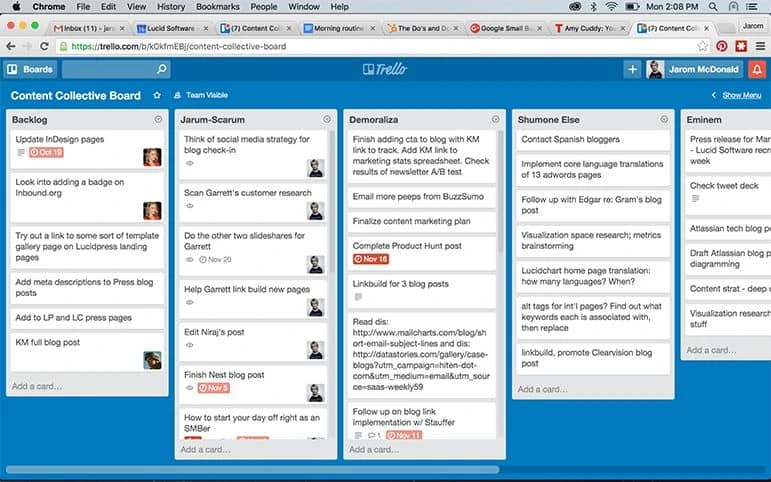
Bonus: Infographic
One more thing. We made a shareable infographic to summarize all these points. Feel free to pass along this image across your social channels!
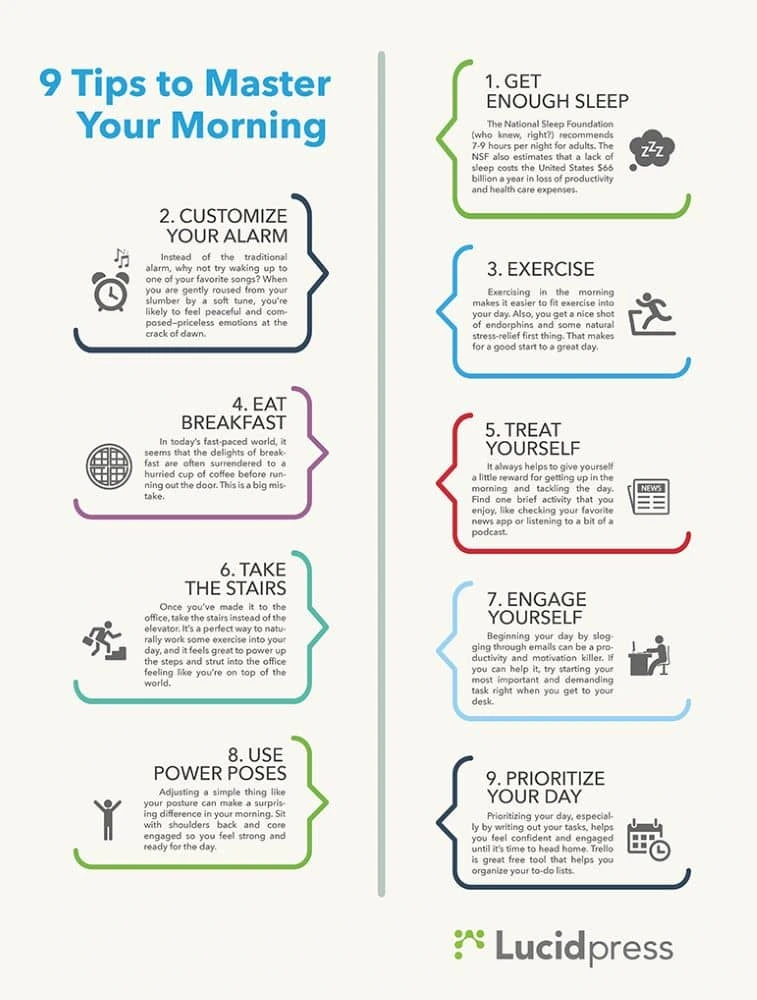
Icons made by: Freepik from www.flaticon.com.
Let us know how these morning routine tips worked for you in the comments below! And feel free to pass along your own tips as well.
Anyone working in today’s busy world knows just how valuable time can be. Without the right resources and goals, you’ll likely lose time and potential customers. AI is stepping up to provide new ways to get more done during your day. New AI productivity tools can help manage schedules, social media accounts, email, security and more.
If you’re looking to save time, automate busy work, or jumpstart your creativity, take a look at these 7 AI productivity tools that bring a little of the future into your present day.
1. Sidekick
Sidekick is a scheduling tool that helps teams automate their calendars and meeting schedules. When you receive an email with a meeting invite, you can simply forward it to your ‘Sidekick’ who will automatically pencil it into your calendar and send a confirmation to your guest.
You can test out Sidekick for free, or pay $5/month to access team scheduling and other perks.
2. Conversica
If you need help qualifying and following up with sales leads, Conversica is your go-to AI software. This AI initiates conversations with your leads, and when the software thinks a potential sale will happen, it notifies a salesperson so they can jump in and close that deal. By using a number of Large Language Models, Conversica is able to create naturally flowing, human-sounding conversations, so leads don’t even know they’re chatting with a bot.
While you can test a free monthly package that allows you to message 25 leads each month, you might get more out of a paid subscription if you need additional assistance. The Professional Edition plan runs around $3,000 for an annual subscription. Pricing depends on which package you choose. The overall cost may seem expensive, but if qualifying leads eats up a large chunk of your business’s time, the investment may be worth it.
3. Trevor
For task management and personal planning, turn to Trevor. This AI connects your to-do list with your calendar so you can perform certain tasks at the best times for you. You just have to tell Trevor what task you’d like to take care of. Say you’re a Creative Direction struggling with managing multiple projects and deadlines. Trevor’s time blocking feature can help you schedule tasks and assign priorities, helping you visually organize your to-do list to prevent overwhelm
The company currently offers a free and ‘pro’ plan for $3.99/month. With the pro plan, you can sync multiple calendar accounts and task list integrations. Plus, your personal Trevor model will update after each session, slowly personalizing the suggestions it gives you.
4. Ironclad
Ironclad is a handy digital contract management tool that helps you draft, edit, negotiate, search, sign, and store your legal contracts all in one place. With an user-friendly drag and drop interface, you can quickly create and launch contract workflows. What’s more, their “dynamic repository” analyzes your storedrecords, offering real time data that teams can use to work smarter.
While there is no set pricing scale, businesses interested in this tool can reach out to get a custom quote.
5. Frontier Secure
In this age of big-name hacks and cybercrime, online security should always be a top priority for businesses, especially those that deal with sensitive information. Frontier Secure keeps tabs on your computers and data to mitigate corruption, theft and loss. It also offers secure cloud storage to keep your content safe and accessible.
Rather than leaving your sensitive information vulnerable to hackers and would-be thieves, you can use Frontier Secure to back up your data and protect it.
Their base plan starts at $64.99/month.
6. Salesforce Einstein GPT
Salesforce, a popular customer relationship management (CRM) application, gets a futuristic makeover with Einstein GPT. For sales teams, Einstein analyzes leads and determines how likely they are to close. Or, if you work in data, Einstein can automate your dashboards and models. With tools for nearly every department, it’s certainly a powerhouse.
The best part? Einstein GPT is built into many Salesforce products, meaning you won’t have to purchase this AI in addition to other tools. No matter how you use Salesforce, Einstein learns and makes suggestions for your benefit.
If you need another way to connect to your customers, don’t worry. Salesforce offers an array of other AI tools to help you with commerce, marketing, customer service and more. Plans start as low as $25 a month (billed annually).
7. ChatGPT
If you’ve been keeping up with new tech, you’ve definitely heard of ChatGPT and its sibling GPT-4. These AI tools have completely changed the marketing game, allowing anyone to create written content and generate ideas. With its ability to scrape all corners of the web, these tools can help users solve complex problems in seconds, opening up new opportunities for team efficiency.
Currently, a subscription to Chat GPT Plus will only set you back $20 a month. However, you can also use this AI tool for free.
Bonus: Marq
As commerce moves from product centricity to customer centricity, it’s incredibly important to build and protect your brand. A strong brand leads to stronger relationships with customers, leads, and the public at large. And, as we know from our research, it leads to stronger bottom lines.
For this reason, enforcing brand consistency across your organization is vital to its growth. But how do you prevent rogue, off-brand content from sneaking through sales teams, people operations, and all the other departments that generate content?
Marq streamlines brand consistency by baking it into the content creation process. When you create documents in our platform, they’re housed in a central location with advanced sharing & editing permissions. All the brand assets you need (logos, colors, fonts, etc.) are accessible from right inside the editor, so no one has to track down the latest approved versions. Plus, you can lock down parts of your documents to prevent future changes—no deleting, moving, hiding or stretching. It’s the simplest way to ensure that your organization’s content is beautifully branded.
Marq offers several pricing options depending on the size of your team and the features you need. However, if you want to give it a test drive, it’s easy to sign up for a free account. You can create documents from scratch or start with one of our hundreds of customizable templates.
Ready to save more time? Marq makes it easy to create beautifully branded content in a matter of minutes.
Theft is a major concern for every business, as losing property almost always results in a loss of profit. For online businesses, however, the greatest concern is not the theft of physical goods, but that of intellectual property (IP). This is particularly true for small- and medium-sized business owners, who depend on their logos, trademarks, designs, and other property of the intellect to make a living.
An online business’s competitive advantage comes from and is built around its ideas, and if these ideas are not properly protected, they can be stolen—resulting in huge financial losses for the business. Incredibly, it is estimated that the cost of intellectual property theft to the US economy could be as high as [small businesses are now being targeted for IP theft](http://www.ipcommission.org/report/IP_Commission_Report_Update_2017.pdf “Cost of IP theft could be $600 billion>$600 billion annually.
Related: 9 red flags when working with a small business marketing agency
It’s important to take preventative measures to ensure that your online business does not fall victim to theft of any kind. So what can you do to safeguard your brand?
Below, we’ve compiled four ways you can protect your brand from the looming threat of intellectual property theft.
1. Trademark your brand
Intellectual property includes artistic and musical works, designs, images, literature and software—all of which help to develop your reputation in a given industry and build customer trust in your brand.
Copyright law covers a lot of the written material that can be found on your website or mobile app, but the components that make up your brand will not be protected through copyright protections alone.
Proprietary rights and trademark protections are sometimes established through consistent use in a given marketplace, but the internet is the wild west, and this kind of recognition in such an open and undefined marketplace is unlikely.
One of the best ways to protect your intellectual property is to register a trademark for your brand name, logo, designs, slogans, and any words associated with your brand. Obtaining a registered trademark for your brand’s IP will allow you to use the registered trademark symbol “®” in conjunction with these assets.
Not only will this deter would-be thieves from stealing your stuff, but it will also give you verifiable proof that you are the original owner of the trademarked material. You will have ground to stand on in the event that the issue is brought to court.
In order to register your brand materials, you must first submit an application with the US Patent and Trademark Office (USPTO). Registration is not automatic, nor is it guaranteed. Three months after you initially file your application, it will be reviewed by an examining attorney, who will check that your intellectual property is in compliance with USPTO rules and regulations.
Compliance is fairly straightforward, but your chance of success will most likely come down to whether you do two things:
Avoid likelihood of confusion
According to the USPTO, “likelihood of confusion” exists if they determine that the applicant’s marks are similar in appearance, sound, meaning or pronunciation to another and the goods or services provided by the two companies are similar enough for consumers to mistakenly believe they’re from the same company.
In order to avoid likelihood of confusion and get your IP certified, you must ensure that the IP of others in your industry is not similar to yours. You can do this by performing a trademark search in the USPTO trademark database.
Reduce similarity with established entity
Trademark registration applications are often declined based on their similarities with already established entities—both public and private. Your application may be refused on these grounds whether the established entity has a trademark of its own or not.
Established entities can include surnames, geographic locations, an individual’s name or likeness, and the names of books and/or movies.
As long as you avoid similarities with these types of entities, you will surely see your trademark application get accepted, and you can continue protecting your brand from IP theft.
2. Link your brand to a source
Generic intellectual property is much more easily replicated, copied and stolen—and thus more likely to be targeted for theft. This is illustrated by the fact that the most counterfeited brands in the world are Nike, Apple and Rolex, which all have relatively simple branding designs and logos.

You can make your brand stand out and decrease the chance of falling victim to intellectual property theft by creating branding material that has greater complexity. One way to achieve this is by linking it to a source.
Your brand can be linked to any kind of attributional source—from names and dates to locations and styles.
For example, if your company were one that (God forbid) sold fidget spinners, you may have adopted a name like “Super Spinners.” Unfortunately, while your company may in fact be super, it also has generic and easily replicated branding. Adding a source to the brand will change that completely. Something like “Silly Steve’s Super Spinners” not only makes it less generic and thus, more appealing, but also more difficult to copy.
This concept applies not only to naming schemes, but also to your logos, slogans, and other words associated with your company.
Attributing a source to your brand will make it a lot more unique—and a lot less likely to become the victim of IP theft.
3. Include an intellectual property clause in your terms & conditions
From a legal standpoint, it’s important to protect yourself and your intellectual property in writing. The best way to achieve this is with a comprehensive terms and conditions (T&C) agreement posted in a conspicuous location on your website or mobile app.
A terms and conditions agreement is a legal statement where you outline the rules and guidelines that users must agree with and adhere to in order to do business with you. It is a fundamental policy for your business and one that will give you the legal backing to deal with abuses and unruly users.

It is within your T&C agreement that you should include an intellectual property clause. This is where you state that all intellectual property—including but not limited to copyrighted material and trademarks—is owned by you and/or the company, and that you have proprietary rights to that material.
Not only will this disclosure give you legal grounds to fight intellectual property theft and copyright infringement, but it might also deter potential thieves from going through with it. They’ll see that you’ve taken precautionary steps to protect your brand, and that you will be vigilant in safeguarding your investment.
It’s important not to limit your IP rights. The wording is crucial and will determine whether your property is properly protected. Consult with a lawyer when drafting this section of the policy to ensure you have full and complete coverage, or use a terms and conditions generator online.
4. Stay vigilant
Legal implications aside, the theft of your intellectual property can have hugely negative effects on your brand—and particularly your market share. If gone unnoticed and unchecked, your stolen IP and branding could carve into your customer base and revenue. It could take years to recover completely from those losses, if ever.
It is extremely important to stay vigilant and monitor your competitors for potential thievery. However, constant monitoring of other sites and businesses is an arduous and time-consuming task.
Luckily, there is software out there that can aid in the battle against IP theft. This software scours the internet for potential matches with your brand and reports back with any infringements. It frees you up to focus on other business matters.
There are also intellectual property agents you can hire to help with the process. They are often licensed attorneys who are trained in intellectual property law. While these agents will be more expensive than computer software (or doing it yourself), the services they offer may end up being invaluable to your brand and the longevity of your business.
Your brand and the intellectual property associated with it are extremely valuable and worth protecting. Litigation and legal proceedings are last resorts, and they shouldn’t be relied on to keep your brand safe. While it’s impossible to completely eradicate theft online, these are fundamental steps you can take to safeguard your investment and give you peace of mind.
The early stages of a brand’s lifespan are crucial because it’s during that time when it’s usually easiest to set expectations and form habits, instead of attempting to do those things for an already established brand or company.
Related: Don’t be busy, be productive—7 ways to use time more wisely
Productivity impacts how efficiently employees get things done, whether a brand’s goals are met, and if teams can complete projects by deadline. Here are 6 tips to help new brands boost their productivity and increase the likelihood of their success.
1. Encourage employees to focus on one thing at a time
One of the typical characteristics of new brands is that staff members fulfill many roles that weren’t part of their initial job descriptions. In other words, they become multitaskers. However, contrary to popular belief, multitasking makes people less productive than doing one task and finishing it before going on to the next one.
The American Psychological Association investigated and found when people attempt to do two things at once, their performance on both of them goes down. That’s because the human brain isn’t designed for multitasking.
A common productivity hack of successful CEOs is that they devote themselves to focused work instead of getting distracted by numerous unfinished tasks simultaneously. It’s smart for the entire workforce associated with a brand to do the same.
2. Understand the power of setting firm boundaries
There’s a common perception—especially at customer-facing brands—that being seen as busy is a good thing. It suggests the brand is thriving and in-demand if flurries of activity consistently characterize its offices.
However, being too busy can negatively impact productivity, especially if it means employees don’t use their time wisely. When new brands set boundaries, whether interacting with clients or deciding how soon a new task can be accomplished, they’ll find it easier to progress steadily toward task completion and not get overwhelmed.
Saying no is difficult for many people in today’s society. They fear that by doing it, they’ll make others regard them as unwilling to accept responsibility or work hard.
Research shows, though, that people find it easier to set boundaries by saying “I don’t” instead of “I can’t.” The latter response suggests a person might want to do something, while the former indicates there’s no room for debate.
When individuals associated with new brands initially get into the habit of effective boundary-setting, they’ll likely feel that they’re letting people down. However, firm boundaries boost productivity by ensuring brand representatives don’t take on too much.
3. Don’t urge workers to sacrifice sleep
Many people who assist with bringing new brands to profitability might only sleep a few hours per night. They justify it by telling themselves things like, “I’ll get back to a healthier sleep schedule after we finish the logo design / once we can hire a full-time social media manager / as soon as we release that new product line,” and so on.
What they don’t realize is that a lack of sleep is probably making their productivity plummet by causing a lack of mental clarity, poor decision-making and other unwanted side effects. Scientists have also discovered that when people don’t sleep, they have trouble regulating and processing emotions.
That could result in a problem where a new brand’s company culture becomes full of tension, frustration and not enough thorough judgment. Plus, when people are deprived of sleep, they might have trouble even keeping their eyes open during meetings. That’s definitely not the tone you want to set in the office.
4. Use some carefully chosen productivity tools
Some productivity tools encourage collaboration, while others block access to certain websites during work hours. Leadership might resist investing in some of them due to a desire to save money. Fortunately, various productivity tools have free options, allowing business owners and others to try them without paying.
Science shows that certain aspects of the workday or environment—such as superiors who constantly interrupt workers or meetings that are too long and frequent—could cut down people’s productivity so much that they aren’t to blame.
Rather, their employers or workplaces are the culprits. That’s why it’s useful to see which productivity tools could reduce interruptions or foster fluid collaboration that would make lengthy meetings less necessary.
For example, a brand templating platform can save your team hours of time by providing brand-approved templates for every kind of marketing collateral. Teams can collaborate on designs and submit them to management for approval. Rather than waiting weeks to get creative work back, everyone has what they need, right when they need it.
5. Don’t waste too much time studying competitors
New brands often get bogged down by paying attention to competitors’ actions. That may seem like a smart thing to do, especially if the competitors are significantly more successful than the newer brand. However, finding success when launching a new brand requires paying attention to the target audience and what they want.
Customers appreciate when brands understand their needs and aim to cater to them. It’s impossible to do those things without getting acquainted with a target audience first.
In one study, 80% of respondents said brands hadn’t ever communicated with them in ways that were too invasive or personalized. So, instead of getting hyper-focused on other members of the marketplace, new brands should be using their resources to get to know their clients.
6. Consider setting “quiet hours”
Most workplaces feature an assortment of sounds—ringing phones, chatter and people typing on keyboards—that eliminates the potential for anything close to silence. As established earlier, people perform their best work when they’re focused on one thing at a time… but noisy workplaces prevent that from happening.
Some companies have established quiet hours intended to increase productivity. During those periods, people cannot send or receive emails. They don’t get or make phone calls during quiet hours, either.
There may be instances where it’s not feasible to stick rigidly to the rules, especially if a person requires email and phone communications to complete a project. When those occasions arise, it’s useful to set aside a particular place for individuals to go—such as an unused meeting room—to take care of activities that cause noise.
Scientists know silence gives the brain a break, and that people subjected to environments with lots of noise are often more stressed than those who are in quieter places.
Depending on what a brand needs to get done, scheduled blocks of silence could help everyone buckle down and accomplish things, then feel refreshed when the noise level in the office returns to its usual din.
Key takeaway: Practice productivity from the start
A brand’s performance could depend on some of the longest-standing principles the company sets in the beginning. Regardless of the industry, productivity is a necessary ingredient for ongoing competitiveness and prosperity.
It’s better for leaders and their employees to adopt solid productivity habits every day than to form bad habits and try breaking them later.
Ready to save more time? Lucidpress makes it easy to create beautifully branded content in a matter of minutes.
What’s the one gift everyone likes to receive? It’s cash.
Seriously, have you ever seen a person trying to return a cash gift or leaving it on a shelf to collect dust? I have never. For some gift-givers, however, cash is too simple and impersonal, so they go for the next best thing: gift cards.
Related: Why brand equity is important & how to measure it
Today, nearly all major retailers offer gift cards, and consumers love them. Stats show that people spend over $130 billion on gift cards per year, which is roughly 0.5% of the entire retail market.
Needless to say, retailers love gift cards, too. They’re easy to implement (especially if you’re an online seller), and besides increasing revenue and ensuring cash flow, gift cards also help with customer acquisition and loyalty.
But the question is, does offering gift cards affect brand equity? In other words, how do consumers, in general, perceive businesses that offer gift cards?
And finally, after all is said and done, should you offer gift cards in your store? (Here’s a hint: gift cards come with some risks but also great rewards for building a brand.)
Risk: Unused gift cards can make your brand look bad
Here’s the thing.
Even though gift cards are one of the most-wanted gifts people look forward to receiving on holidays & birthdays, nearly one-third of consumers never use the gift cards they’ve received.
That’s where your brand equity could suffer.
Stats show that out of $130 billion spent on gift cards, approximately $1 billion is lost in unredeemed gift cards. The gift card & credit card marketplace CardHub even found that between 2008 and 2014, consumers had lost over $44 billion in the form of unused credits.
A study by Dan Horne analyzed the impact of unredeemed gift cards on businesses, and it concluded that too many unused gift cards can harm the brand’s image. When gift cards are left unredeemed, the company basically gets money for nothing. “Consumers feel that retailers have taken advantage of them,” the author concludes.
Besides the people who forget about their gift cards, there’s another group: those who try to get rid of an unwanted gift by reselling it online. The problem is, the more often your brand’s gift cards are sold off online—via social media or on platforms specifically created for reselling—the less valuable they’re perceived to be.
Think about it.
The fact that many people are trying to get rid of your store’s gift card makes the products you sell look unwanted. Besides, the more users selling gift cards from the same brand, the lower resale price they offer. That may lower consumers’ perceived value of your products, and your business may start to find it difficult to sell them for the full price.
Rewards: Increased brand awareness, trustworthiness & reliability
Despite the challenges gift cards may pose for your brand, they’re still a great marketing & branding tool.
First of all, gift cards increase brand awareness.
“Imagine a gift card as a tiny billboard advertisement for your company inside the wallets of your customers. Every time they open up their wallets to pay for something, they see your brand on their gift card,” explains Ruby Camara, Chief Customer Officer of SixthContinent.
By offering gift cards or certificates in elegant custom packaging, you can boost your brand’s perceived value. Perhaps even more importantly, it helps your gift-buying customers look as though they’ve put more thought & consideration into choosing the gift.
“Gift cards may be small in size, but these mini-billboards come with very large branding opportunities,” concludes Dana Lambert, Associate Creative Director for The Motion Agency.
Secondly, gift cards can boost your brand’s trustworthiness.
Let me explain.
Having your gift cards placed in stores next to big players like Apple & Starbucks makes your business look like one of the big players, too. That’s a great way for lesser-known brands not only to attract more eyes but also to improve their trustworthiness.
Now, if selling your gift cards in stores is not an option for your business, offering digital gift cards might do.
According to Canadian POS, “Stores that sell gift cards are representative of the upper echelon of retailers.” That is, adding gift cards to your product catalog causes shoppers to perceive your brand more seriously. “This is most likely due to the fact that all major retailers offer gift cards,” Canadian POS assumes.
SixthContinent, a platform that offers gift cards for brands of all sizes in one place, believes that it’s beneficial for small companies to be placed next to big brands. “That increases the visibility and, eventually, the sales of that company as well,” they observed.
Finally, gift cards increase customer loyalty.
And loyal customers make your company look reliable.
When shoppers keep returning to the same retailer for more, it shows other potential customers (and the general public) that this company is doing something right.
When it comes to gift cards, studies show that it’s an effective way to build a loyal customer base. It’s been found that referred customers—including those who’ve discovered a brand through a gift card received from a friend—are likely to become loyal return customers as well.
By giving gift cards to friends and family, we show that we trust a brand enough to recommend it to people we care about. We put those mini-billboards into friends’ wallets, and that way, we make sure they keep thinking of the brand. That’s the perfect recipe for building brand loyalty.
Key takeaway
Gift cards offer great possibilities for improving brand equity—on the condition they’re actually redeemed. Companies that see gift cards only as an additional revenue source and hope to make extra money “for nothing” will lose the game in the long-term.
Ready to design your own branded gift certificates? Hop over to our free template gallery and get started!
As Coronavirus has spread, the number of people and businesses willing to step up and help has been impressive. Yet, keeping track of every free service and product has been overwhelming for our team. Rather than lose track of all of the resources & ideas passed via Slack and email, we’ve curated a list of resources for living in this difficult period. Use the clickable directory below to find the topics relevant to you.
Refer to official sources for all healthcare information.
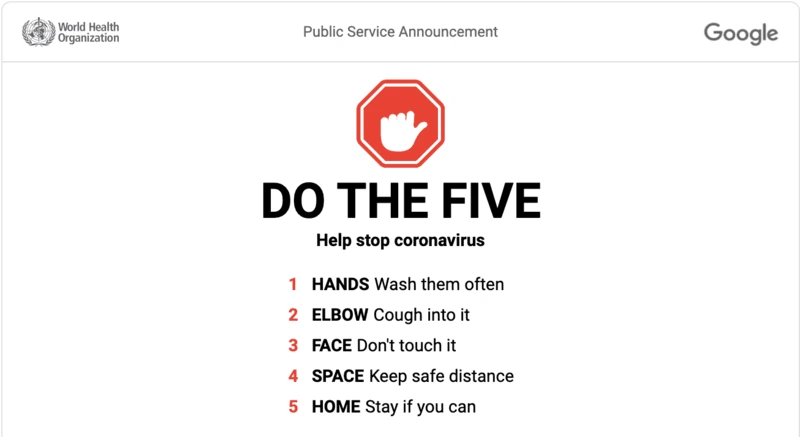
For Schools & Universities
Free Internet
Charter Communications
Charter Communications, which operates under the Spectrum brand, offers 60 days of free broadband, Wi-Fi and installation to households with K-12 and college students who don’t have Spectrum service. Professional or self-installation is available and can take one to seven days.
Comcast Corp.
Comcast Corp. said it would offer 60 days of free internet service to low-income families, who live in the company’s service area and sign up as new customers. Self-installation kits would be shipped for free with no term contract or credit check. After 60 days, customers would be charged $9.95 per month plus tax unless service is cancelled. The offer is available through April 30.
Cox Communications
Cox Communications said new customers will receive their first month of free service and installation to families enrolled in low-income assistance programs. After 30 days, customers will be charged $9.95 per month plus taxes. The offer expires May 15.
Library access
Internet Archive has suspended all waitlists for its 1.4 million books in its lending library. National emergency library
Curriculum
Weareteachers.org
130+ Online Learning resources
PBS Learning Media
Virus information & protection
Distance learning resources searchable by subject and grade
https://utah.pbslearningmedia.org/
Edhelper
Free daily math and writing workbooks
https://www.edhelper.com/teacher-education/best-teaching-and-classroom-ideas.htm
Learn at home resources for families:
https://docs.google.com/document/d/1b3-8S2b6klEfAKRbrDLflJj-6JS7Dp6QyjNlElyck1Q/edit
Virtual field trips
Zoos
Aquariums
- Georgia Aquarium’s Ocean Voyager webcam
- “Jellycam” at Monterey Bay Aquarium
- Virtual tour of the National Aquarium
- Seattle Aquarium 30-minute video tour
Farms
Planetariums
Museums
- Boston Children’s Museum
- The National Museum of Natural History’s virtual experiences
- Metropolitan Museum of Art
- Google Arts & Culture
- National Constitution Center
- Colonial Williamsburg
- Ellis Island
- The Louvre Museum
National/State Parks/Nature
- The U.S. Geological Survey interactive map
- The Nature Conservancy offers 11 virtual field trips
- Yellowstone interactive maps, Old Faithful Geyser live-stream
- Virtual field trip from Great Lakes Now
Global
Virtual Book Readings
List of children’s book authors doing online read alouds and activities by age group
Entertainment
Movies released for streaming/purchase
March 13
Star Wars: The Rise of Skywalker (iTunes, Prime Video)
March 15
Frozen 2 (Disney+)
March 20
The Invisible Man (iTunes, Prime Video)
Emma (iTunes, Prime Video)
Onward (Disney+)
March 24
Birds of Prey (iTunes, Prime Video)
Bloodshot (available to purchase for $19.99)
Just Mercy (SharePlay Video)
The Gentlemen
The Way Back (available to purchase for $19.99)
March 27
I Still Believe (available to purchase for $19.99.)
April 10
Trolls World Tour (releasing the film digitally and for streaming on the same day)
Movies about Pandemics
Contagion (2011)
This fast-paced thriller charts the rapid transmission of a virus across the globe as scientists hurry to find a vaccine and social order disintegrates.
Available to stream in the US at: MaxGo and Amazon Cinemax
UK: Paid rental – including Amazon, Sky Store and Chili
Australia: Paid rental – including Google Play and iTunes
The Crazies (1973)
When a military plane carrying an untested bio-weapon crashes in the hills of a nearby American town, their water supply becomes contaminated causing local residents to die or become homicidal. The government draft in the military to quash the spread of the disease, given instructions to shoot on sight.
Available to stream in the US: Amazon Prime Video and VUDU
UK: Paid rental – including Amazon and Sky Store
Canada: Paid rental on Google Play and YouTube
Australia: Not available
Outbreak (1995)
Opening in Zaire, Africa, a fictional disease called Motaba spreads to California after an infected capuchin monkey is smuggled into the country. The disease develops into a strain of influenza, and the small town of Cedar Creeks is placed under martial law as
Available to stream in the US: Netflix
UK: Paid rental – including Amazon, Chili and iTunes
Canada: Paid rental – including Cineplex and iTunes
Australia: Paid rental on iTunes and Microsoft
Twelve Monkeys (1995)
Twelve Monkeys is a dystopian sci-fi fantasy set in post-apocalyptic Philadelphia in 2035. As most of humanity was wiped out by a virus in 1996, Earth’s remaining inhabitants live underground.
Available to stream in the US: FuboTV and Amazon Showtime
UK: Not available
Canada: Amazon Prime Video and Crave Starz
Australia: Paid rental – including Google Play and iTunes
Last Man on Earth (1964)
It revolves around the monotonous routine of Doctor Robert Morgan that, in the wake of a virulent plague, has left him the last human alive. Although rather dated and low-budget, it’s an evocative portrayal of crushing loneliness, with Morgan patrolling the streets during the day to kill the infected undead, only to return home alone at night to barricade himself against the vengeful hordes.
Available to stream in the US: Amazon Prime Video and Hoopla
Canada: Amazon Prime Video
Australia: Kanopy and Amazon Prime Video
It Comes at Night (2017)
In the aftermath of a planetary contagion, a lone family exist deep in the woods until a handful of survivors cross their paths – father Will, mother Kim, and their son Andrew. Although initially distrustful, they agree to share resources and begin to bond. But, following a series of strange incidents, suspicions start to emerge that maybe one of them isn’t well after all.
Available to stream in the US: Netflix and Kanopy
UK: Paid rental – including Amazon, iTunes and Sky Store
Canada: Paid rental – including Cineplex and iTunes
Australia: Kanopy
The Host (2006)
Like The Crazies, the film shows mankind sow its own destruction when an American pathologist instructs his Korean colleague to dump formaldehyde in the Han River. A few years and lots of dead fish later, a gigantic amphibious creature emerges, attacking the local residents and kidnapping a young girl called Hyun-seo. As the military arrive to quarantine the area, they declare that not only is the mutant dangerous, but that it carries an unknown virus too.
Available to stream in the US: Roku Channel and Hoopla
UK: Paid rental – including iTunes and Sky Store
Canada: Hoopla
Australia: Paid rental – including Microsoft and Google Play
28 Weeks Later (2007)
Those infamous scenes of Cillian Murphy walking through an abandoned London in 28 Days Later (2002) seem eerily prophetic in the wake of coronavirus. The 2007 sequel however begins after the outbreak of the rage virus, with the infected dying of hunger and NATO instigating a safe zone in the capital.
Available to stream in the US: Paid rental – including Amazon and DirecTV
UK: Paid rental – including Amazon, Sky Store and Chili
Canada: Paid rental – including Cineplex and Microsoft
Australia: Foxtel Now
Day of the Dead (1985)
Although less well regarded than Romero’s first two entries in The Dead series, Day of the Dead aptly captures the sense that, in a world where zombies outnumber humans 400,000 to 1, there’s nowhere left to run.
Available to stream in the US: Max Go and Flix Fling
UK: Paid rental from the Sky Store
Canada: Tubi TV and Flix Fling
Australia: Amazon Prime Video and Kanopy
Zombieland (2009)
Starring Jesse Eisenberg as Columbus and Woody Harrelson as Tallahassee, they’re two mismatched survivors: one has an extensive set of rules to keep alive (“Rule 22: When in doubt know your way out”), while the other is happiest eating Twinkies and kicking ass.
Available to stream in the US: Paid rental – including Amazon and DirecTV
Canada: Netflix and Crave Starz
Australia: Netflix
Free virtual concerts
List of concerts by date and genre
Books
Scribd- free access for 30 days
Libby- ebooks and audiobooks from your local library
Virtual Events
Virtual Parties
Virtual Book Clubs
Quarantine book club
Join your favorite authors on Zoom where you can have spirited discussions from the privacy of our own quarantined space! Quarantine book club
Our Shared Shelf
Actress and activist Emma Watson runs Our Shared Shelf, a feminist book club with over 100,000 members. Each month the group chooses a new book that deals with themes of race, gender, and justice, and opens up a friendly, literary dialogue on Goodreads.
Oprah’s Book Club 2.0
You can’t possibly talk about nationwide book clubs without talking about Oprah. Lucky for all of us, Oprah’s Book Club 2.0 is still around to bring us all challenging and inspiring stories straight from Oprah’s shelf.
Virtual Movie Night Apps
Virtual dance party apps
Instagram Live
Zoom
Video Games
Epic Games
Download Watch Dogs and The Stanley Parable free of charge
GOG
27 free games for PC users
https://www.gog.com/partner/stay_at_home
Jackbox Games
Drawful2 is available free on Stream
Free virtual board games
6 Best Sites to Play Board Games Online for Free!
Virtual music lessons
Fender is offering 3 months of free guitar lessons through its online learning platform
Health & Fitness:
High Intensity Classes
Orangetheory: Orangetheory is now uploading new at-home 30 minute workout routines daily.
Barry’s: Barry’s is rolling out complimentary, twice-daily IGTV Barry’s at-home workouts.
Rumble: This killer boxing studio is hosting daily Instagram Live videos featuring cardio and body weight workouts every morning.
Toning and Dancing Classes
Tone It Up: The app will be free for new users for the next 30 days, and workout videos range from 10-40 minutes to fit your schedule.
P.volve: This functional movement fitness program just announced it will be offering 30 days of free streaming to all new members, which gives you access to hundreds of workouts.
305 Fitness: Founder Sadie Kurzban is now offering free cardio dance live streams twice a day on YouTube at noon and 6PM EST.
OBE Fitness: Use code SWEATSANDCITY for your first month of at-home workouts free.
Bandier: Bandier will be hosting Instagram Live workouts every day at 4PM EST that can be done at home.
Dance Body: This awesome dance fitness workout is offering a free 7-day trial of their DanceBody LIVE platform and 50% off your first month with code DBATHOME.
Physique 57: Enjoy a 7-day free trial of their app here.
Yoga Classes
CorePower Yoga: CorePower Yoga is offering free streaming live classes for you each day.
Lululemon:will be hosting free Instagram Live sessions that feature yoga, do-anywhere workouts, meditation, and self-care tips.
Skyting: is offering a one week free of their yoga television platform.
Y7 Yoga: is offering Flow On Your Own Instagram Live sessions throughout the week.
Celebrity Trainer Classes
Don Saladino: is offering a free 4-week bodyweight training program
Fit Body: new members of the app will be able to take advantage of it for free for the next 30 days. Go to www.fitbodyapp.com, select the 1 month membership, and enter code DAJEITALIA at checkout.
Transform HQ: They’ll be offering 30 days of free workouts and recipes in their exclusive Transform App Users Community on Facebook.
Mix Classes
Peloton: Peloton is now offering a 90-day free trial of their yoga, meditation, strength, cycling, running, and other fitness classes to anyone for use.
Redeem Fitness: Redeem’s online workout platform will be free for the next 30 days. Visit redeemfit.com/sign-up and use coupon code REDEEM1.
Daily Burn: They are offering a 60-day free trial with premium access as well.
Planet Fitness: Planet Fitness will be hosting “Home Work-Ins” – a series of free fitness classes for everyone – that will be streamed live on Planet Fitness’ Facebook page daily at 7 p.m. EST.
YMCA: A new free online community program, YMCA 360, offers on-demand programs and digital coaching.
24 Hour Fitness: Everyone can access the 24 Hour Fitness app on-demand workouts and premium content for free during this time.
Gold’s Gym: Try one of the over 600 audio and video workouts on the Gold’s Gym AMP app, which they are offering for free through the end of May.
Life Time: You can participate in new classes added daily on demand from Lifetime as a way for members (and non-members) to stream cardio, strength, and yoga classes absolutely free.
Blink Fitness: Blink Fitness is now live-streaming workout videos at 8AM EST on weekdays called Get Up and Blink!
Mental Health
Virtual Therapy
Rachel Wright, a New York City-based therapist, is holding virtual group check-ins for free.
Sign up Here: https://rachelwrightnyc.lpages.co/popup-support/
Apps
Calm: The Calm app is offering free resources right now to help you meditate, sleep, and stretch.
Headspace: Headspace is offering free subscriptions right now to help people de-stress.
Daylio: tracks mood and daily activity
Simple Habit: is offering free premium memberships right now. To get one, email help@simplehabit.com
Online Resources
The Science of Well-Being- Free course from Yale
Social media accounts to follow
Therapist Nedra Tawwab posts to her Instagram feed with bite-sized ideas for reducing stress and staying in the moment.
Amy Morin, another therapist, is sharing kid-friendly mental health tips on her Instagram account.
Jennifer Rollin, a therapist who specializes in eating disorders has been posting helpful tips for coping during a time of food stockpiling.
LGBTQ resources
The National Center for Transgender Equality
https://transequality.org/press/releases/the-coronavirus-covid-19-what-trans-people-need-to-know
Trevor Project’s youth counselors
https://www.thetrevorproject.org/
SAGE National LGBT Elder Hotline
https://www.sageusa.org/what-we-do/sage-national-lgbt-elder-hotline/
Trans Lifeline
Trans Lifeline is reopening the microgrant application on April 1 at 1 PM ET to provide financial assistance for transgender people in need. http://www.translifeline.org/
Community Service
Food banks: Donate money and food, volunteer
Feeding America is another source for food banks across the country that are seeking financial support as part of its response to COVID-19.
Remote volunteer opportunities
Alone is an organization that provides companionship to the elderly. There’s an option to become a telephone volunteer where you call and check-in at least two hours each week
iCouldBe is a virtual student mentorship program where you dedicate one hour each week for the school year.
Crisis Text Line, where you would be a remote crisis counselor. The organization is asking for volunteers especially between 7 p.m. and 3 a.m. PT
Donate blood
The Red Cross is facing a “severe” blood shortage as a result of mass donor cancellations during the coronavirus outbreak.
Give to organizations helping with medical costs
HealthWell Foundation provides financial assistance to help with prescription co-pays, health insurance premiums, deductibles and coinsurance.
GlobalGiving has a coronavirus relief fund that you can donate to as well. Donations go toward medical supplies, delivering essential items to struggling families and older individuals in quarantined cities, feeding children that rely on school meals and more.
Order takeout or delivery from a local restaurant
Local Lists:
Save Our Faves in San Francisco
Utah restaurants offering curbside pickup
Direct restaurant delivery in Utah
Help the elderly
Alleviate loneliness with regular phone calls, video calls, video messages and text-based chats. Send photos, fun articles, puzzles, adult coloring books and other items to help keep your loved ones and neighbors feeling connected. Consider establishing an upbeat daily call.
Offer to pick up groceries and other supplies and offer to bring them meals several times a week — you can arrange to leave them on the porch so you don’t risk spreading germs.
Babysit
Healthcare workers and others who must continue to work need help with childcare. See childcare section for more information.
Nonprofits to contribute to:
List of nonprofits from the WashingtonPost
Utah nonprofits:
https://coronavirus.utah.gov/help/
Unemployment Resources
What you need to know:
- How unemployment insurance works
- Who and what the new paid leave law covers
- How to pause your federal student loans
- You have three more months to file your federal taxes
- Help for renters and homeowners
- Ways to keep the lights on and the phones working
- More advice that will help
Businesses across the U.S. and Europe who are hiring:
Small Businesses
U.S. Chamber of Commerce Coronavirus response toolkit
The U.S. Chamber of Commerce put together this toolkit to help businesses and citizens alike understand how to navigate the coronavirus. There are guidelines on how small business owners can ensure they are keeping their customers and employees safe.
Disaster assistance loans from the SBA
The SBA announced it would offer disaster assistance loans for up to $2 million for small businesses affected by the coronavirus. These low-interest loans are available to businesses that have sustained “substantial economic injury” due to the spread of the coronavirus.You can find a regularly updated list of states where disaster assistance is being offered here.
Assistance from banks
Capital One, Citi and Wells Fargo have all issued statements indicating that they are willing to work with customers that experience financial difficulties. Citi issued a statement that for 30 days, small business customers are eligible to have their monthly service fees waived.
Citi is also waiving the fees on early CD withdrawals.
Coronavirus small business guide
The coronavirus pandemic is affecting small businesses in a variety of ways. CO— is working to bring you the best resources and information to help you navigate this challenging time. Full guide
Work-from-home
Adjusting to working from home
Linkedin Remote Work Learning paths
16 courses on adapting to and working productively from home
Working From Home? 12 Guides To Help Navigate The Remote Life
A roundup of 12 Trello blog posts
Working from home with kids
https://www.parents.com/parenting/work/life-balance/how-to-master-being-a-work-at-home-mom/
Free Conference Calling
Microsoft
Microsoft has started offering a free trial of the premium plan for its Teams chat app. Microsoft is making the extended premium trial available for six months.
Google will allow free access to the enterprise version of Hangouts Meet to all G Suite and G Suite for Education users. That plan includes up to 250 users per call, the ability to record meetings, and livestream capabilities for up to 100,000 viewers until July 1, 2020.
LogMeIn
LogMeIn is making “Emergency Remote Work Kits” available for free for three months. Those kits are designed for nonprofits, schools, and health care organizations that aren’t already customers. The company also says it will work with existing small-business customers to provide access during the same time period. The kits include GoToMeeting, GoToWebinar and LogMeIn.
Cisco Webex
Cisco is offering the free version of its Webex service with no time restrictions. In addition, it will allow up to 100 meeting participants and has added toll-free dial-in features with a 90-day license for businesses that are not already customers.
Zoom
Zoom already offers a free version of its video conferencing software, but the company is currently working to test its network to “ensure maximum reliability amid any capacity increases, as uptime is paramount,” according to a blog post from the company’s CEO.
Parents
Children’s Entertainment
Books
Free children’s stories via Audible
https://stories.audible.com/discovery
Virtual Book Readings
List of children’s book authors doing online read alouds and activities by age group
Virtual art classes
Drawing with Deborah Putnoi
Deborah Putnoi is taking to Facebook to offer live, virtual alternatives to in-person art classes. Putnoi is broadcasting live every Monday through Friday at 2 p.m. for free.
Lunch doodles with Mo Willems
Learners worldwide can draw, doodle and explore new ways of writing by visiting Mo’s studio virtually once a day for the next few weeks. https://www.kennedy-center.org/education/mo-willems/
Illustration with Jarrett Krosoczka
Jarrett Krosoczka is an author and illustrator and posts videos of his illustration process on YouTube. He has started posting daily livestreams at 2 p.m. on his channel under the series titled “Draw Every Day With JJK,”
Virtual field trips
Zoos
Aquariums
- Georgia Aquarium’s Ocean Voyager webcam
- “Jellycam” at Monterey Bay Aquarium
- Virtual tour of the National Aquarium
- Seattle Aquarium 30-minute video tour
Farms
Planetariums
Museums
- Boston Children’s Museum
- The National Museum of Natural History’s virtual experiences
- Metropolitan Museum of Art
- Google Arts & Culture
- National Constitution Center
- Colonial Williamsburg
- Ellis Island
- The Louvre Museum
National/State Parks/Nature
- The U.S. Geological Survey interactive map
- The Nature Conservancy offers 11 virtual field trips
- Yellowstone interactive maps, Old Faithful Geyser live-stream
- Virtual field trip from Great Lakes Now
Global
TV Shows
Amazon Prime has made a selection of kid’s shows free for anyone to stream.
Childcare
Care.com
Care.com is providing 30 days of free, premium access to their site for all healthcare workers and seniors. https://www.care.com/vis/covid19FtpLandingPage
Stepuptosit
Connects older students home from school to babysit for families of essential workers.
Sittercity
Sittercity is giving all Chicago parents working as a first responder 3 free months of Sittercity Premium. https://family.sittercity.com/chicagoresponds/
Joinweekdays.com
We’re offering this free service to match families and teachers/parents who can offer care in-home due to the COVID-19 child care crisis.
Portland nursing students
Medical and dentistry students at Oregon Health & Science University and nursing students at the University of Portland are offering to watch children, run errands and go grocery shopping, free of charge, while their classes are suspended. The assistance program is open to all health care workers in the Portland area.OHSU employees can send texts to Graulty’s and Lane’s pagers to get the form. Twitter users can send a direct message to Lane at @EmilyCALane. There’s also a program hotline: 503-383-9776.
Meals
50+ places where families can get free meals for kids during COVID-19.
https://parade.com/1013234/stephanieosmanski/free-meals-for-kids/
Talking about Coronavirus
Nickelodeon
Content provides “kid-appropriate, kid-directed” information using original short-form videos, downloadable activities and social content.
PBS Learning Media
Virus information & protection
NPR’s Just For Kids:
A Comic Exploring The New Coronavirus
Child Trends
Resources for Supporting Children’s Emotional Well-being during the COVID-19 Pandemic
Sources:
https://www.weareteachers.com/free-online-learning-resources/
https://www.weareteachers.com/virtual-author-activities/
https://time.com/5805624/movies-streaming-early-coronavirus/
https://www.techradar.com/news/the-top-10-best-pandemic-movies-you-can-stream-right-now
https://www.goodhousekeeping.com/health/fitness/a31792038/coronavirus-live-stream-workout-classes/
Author’s note: At the end of the day, we want this blog post to offer a little bit of reprieve. And, if we’re being honest, we hope it’ll make you laugh a little too. Because we could all use a little laughter in our lives. Stay tuned for a comprehensive download on everything that entails creating a BCP, as well as access to the business continuity plan template.
Two words: dumpster fire.

If you’re unfamiliar with the term, Merriam-Webster defines it as “an utterly calamitous or mismanaged situation or occurrence.” As a business owner, it’s safe to say that you’d probably like to avoid them at all costs. But as John Lennon so famously iterated, “life happens when you’re busy making plans.”
What’s the purpose of a business continuity plan?
In the event of a crisis (big or small), you want to ensure business continuity, as well as an ability to secure the safety of your employees in some way, shape or form. Meaning, you want to be able to maintain or work toward business recovery and functionality. And a business continuity plan helps you:
- Maintain business functionalities.
- Manage crisis-related hurdles.
- Resume business functionalities.
- Recover from the crisis accordingly.
What’s the difference between a business continuity plan and a disaster recovery plan?
You’ve probably seen the terms “business continuity plan” and “disaster recovery” used in the same sentence — likely because a disaster recovery plan functions as a subset of a business continuity plan.
Simply put, a business continuity plan works:
- To ensure business as usual — i.e., maximum functionality despite circumstances.
- To gain validation and assurance from and for stakeholders of your business.
Whereas a disaster recovery plan refers to:
- A pre-existing emergency procedure or process that a business implements during a time of crisis to protect any IT infrastructure.
- A crisis can be:
- Ecological – Also known as environmental disasters, ecological disasters usually occur because of humans. Examples would be the long-term side effects of a nuclear event or an oil spill.
- Natural — Disastrous natural events include floods, hurricanes, earthquakes and more.
- Human-made — Similar to ecological disasters, human-made disasters also happen because of human actions as well as a lack of action.
So, all that said, how do you write a business continuity plan? Let’s dive in.
How to write a business continuity plan
There are five core components you need to define and implement before going hog-wild on a business continuity plan template. The more time and effort you put into creating a thorough and well-thought business continuity plan, the better off you’ll be — no matter if you’re leveraging a small business continuity plan template or a BCP template for a large-scale organization.
More specifically you need to:
- Create a business continuity team
- Define objectives
- Conduct a business impact analysis
- Write and define your response plan
- Set a testing schedule
Over the next few paragraphs, we’ll expand on what steps you need to take and things you need to create an effective business continuity plan.
Create a business continuity team
To get started, you’ll want to assemble a business continuity team. These folks will function as your business continuity management group and handle the ideation, development and implementation of your business continuity plan. Whomever you nominate should have a sharp attention to detail and be both highly organized and dependable in times of stress.
- Executive manager — Responsibilities include: writing the business continuity process and serves as the liaison between your business continuity team and executive management or board members.
- Program coordinator — Responsibilities include: functioning as team lead for business continuity team, handling coordination in regards to plan development, budget and recovery procedures.
- Information officer — Responsibilities include: Sharing data information related to the business continuity plan.
Define objectives
There are two factors you want to consider as you evaluate and define your objectives.
- Your end goal — What is the end goal you’re looking to achieve by creating this plan? Are you looking to resume business as usual? Are you looking to recover a certain amount of financial standing? By defining your end goal, you’ll be able to narrow down the scope of your business continuity plan to ensure it feels both tangible and realistic.
- Your budget — What kind of budget can you expect to allocate for? As in, how much can you allocate toward resources to execute and achieve your business continuity plan?
Once you’ve defined your objectives, you’ll have a clearer perspective and understanding of how to go about putting together the business continuity plan.
Conduct a business impact analysis
To get a firm grasp on your budget, you’ll want to conduct a business impact analysis. A business impact analysis provides insight into costs, benefits and prioritization.
According to Ready.Gov, a Department of Homeland Security website, a business impact analysis (also known as a BIA) “predicts the consequences of disruption of a business function and process and gathers information needed to develop recovery strategies.”
As in, what happens when one functionality breaks down? What else does this loss of functionality impact? For example, say you’re a food distribution business and one of your trucks breaks down — how does this affect your delivery and operations?
Write and define your response plan
Great news! You and your business continuity team are on track to completing a concise yet simple business continuity plan template.
Now, you’ll need to brainstorm, write and define your response plan. Keep in mind, this BCP will be your first draft, so not everything will be set in stone right off the bat.
Within your response plan, you’ll need to include:
[Program administration]
- Purpose
- Objectives
- Financial limitations or budget
- Expected timeline
[Governance]
- Team roles and responsibilities
- Additional stakeholders
[Business impact analysis]
- Your BIA
[Strategies and requirements]
- Your proactive approaches to prevent crises
- Your reactive strategies to ensure immediate response to crises
- Your reactive strategies to ensure long-term recovery
[Training and testing]
- Your training schedule for employees
- Your testing schedule
If you’re so inclined, you can easily leverage one of our existing business continuity templates to your advantage. All you need to do is plop any existing information into the corresponding fields, and get to testing, which leads to our next and last step….
Set a testing schedule
As tempting as it might be to call it in when you’ve wrapped up your business continuity plan, you should err on the side of caution and give it the old test-a-roonie. A test ultimately helps you identify potential hurdles, soft spots or holes in your plan, so when push comes to shove and a crisis does arise, you’re not left having to deal with a colander for a lifeboat during your time of need.
To start testing, communicate with and train each team member about the steps they’ll need to take when implementing the business continuity plan. Then, you’ll conduct a test trial of your BCP — be sure to make a note of any holes or gaps in the plan or execution of the plan itself as you’ll need to come back to these and fix them.
You’ll want to consistently and periodically test your BCP for any hiccups. Plus, your company and organization are bound to change, and you need your BCP to be agile and grow with your company as it grows, too.
Creating a BCP for recovery
Ultimately, the last thing you want to be dealing with when you’re navigating a crisis is to be dealing with, well, the fallout of an unplanned emergency. And not only that, you want your employees to remain as safe and secure as possible. After all, they are the driving force behind your business productivity and functionality, which is why you must ensure that your business continuity plan provides the best chance of recovery possible.
Uncover how our business continuity template can help you, your business and your employees.
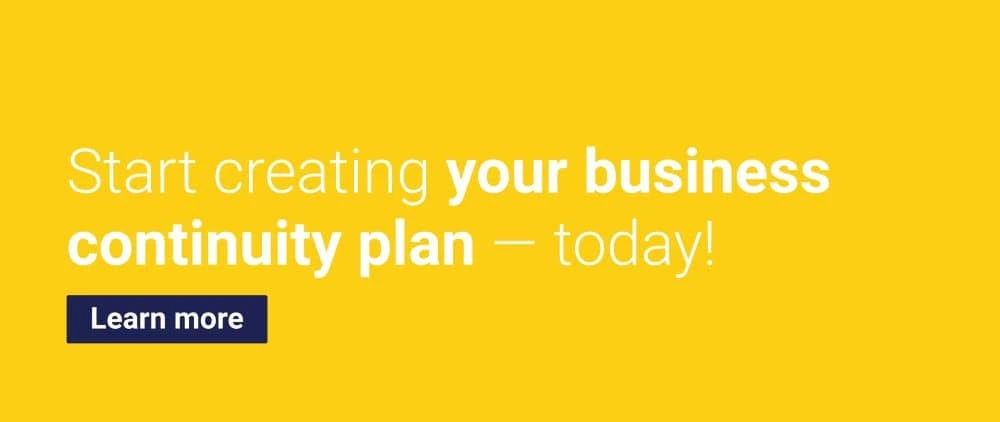
Social media typically ranks among the top three sources of website referrals for most brands. And it’s affordable. Regardless of whether you have a budget of $0, $1,000 or $100,000, you can achieve your social media marketing goals with smart content and targeting.
Related: 7 serious social media mistakes that brands still make
The beauty of social media marketing is its umbrella of benefits. Its ROI isn’t restricted to the website conversions you see from social media referrals. It extends beyond that to include expanded brand awareness, mindshare, and the delayed effect of your social media campaigns on future purchase decisions. To create campaigns that deliver those benefits, you need to consider certain critical elements.
Things to consider before your next social media campaign.
1. Goals and outcomes
What does your brand want to achieve with social media? Defining this is necessary to set a sufficient budget, choose the right social media platforms, and create the right content.
Most businesses will track several different metrics from the table below to measure the success of their social media marketing strategy. While awareness and engagement metrics may be seen as “vanity metrics”, they can be a great way to gauge whether your content is resonating and will help drive conversions long-term.
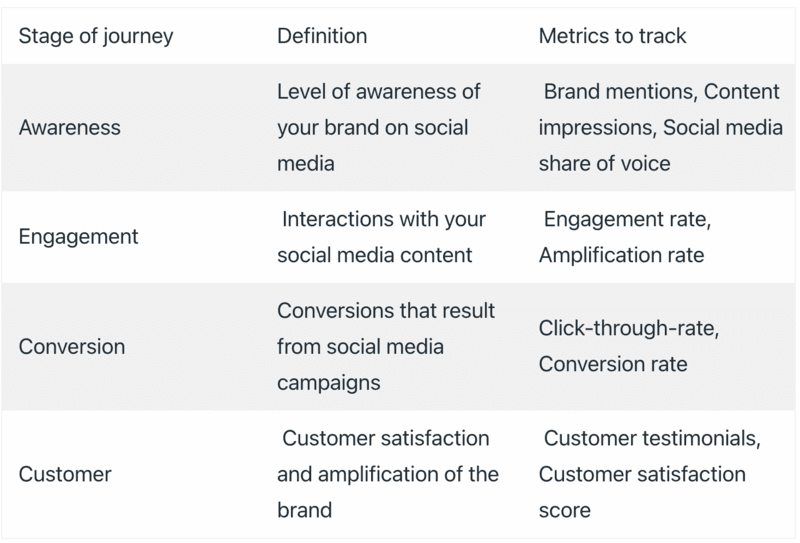
Once you have your goals, it’s important to focus on discovering what your customers’ goals are, so you can “figure out how your social media strategy connects both,” as Lee Odden, CEO of TopRank recommends. If you want people to pay attention to your content, the narrative should focus on them and not you—what value can you add to their lives? Which of their problems can you solve? To create such a narrative, you need clarity on your goals and your customers.
For instance, consider stem cell corporation LifeCell. Their goal was brand awareness among expectant mothers whose primary goal would be the safety and happiness of their children. So, they created posts that focused on the precious moments mothers share with their infants, like this one.

Target audience: Who is the ideal audience for this campaign? Most social media platforms provide options to filter your audience. Not all campaigns are designed to speak to your current customers—in fact, a good social media campaign should grow your audience and attract new followers. Think about the demographics and interests of your ideal audience, and target them accordingly.
Message: What is the main idea you’re trying to communicate with this campaign? Make sure your message is clear and focused. After all, attention spans are short on social media, so you’ve only got a few seconds to get your point across. Also, a word to the wise: Keep track of trending topics before delivering your message. A post that seemed like a great idea yesterday could be misinterpreted based on the news today.
2. Platforms and social networks
It’s never a good idea to spread yourself too thin by managing too many social media platforms. Especially if you’re a small business with limited budget and capacity, you’re better off choosing one primary social platform, so you can publish tailored content and fully participate in the responses you receive.
Facebook is a safe bet for most brands, since it’s become so ubiquitous. But for certain industries, such as fashion or food, image-sharing platforms like Instagram might provide a better rate of return.
Similarly, LinkedIn often works very well for B2B brands because it’s geared towards professionals. Research and choose a couple social media platforms that will best benefit your brand before starting a campaign.
To identify the best social media platform for your brand, you could simply survey your customer base or analyze your competitor’s social media presence. Choose the platform where most of your customers are active and where your competitors are receiving the best response. Alternatively, you could cross-post your social content to effortlessly create a multi-platform presence. Doing this manually is time-consuming, but an automation tool can simplify the process.
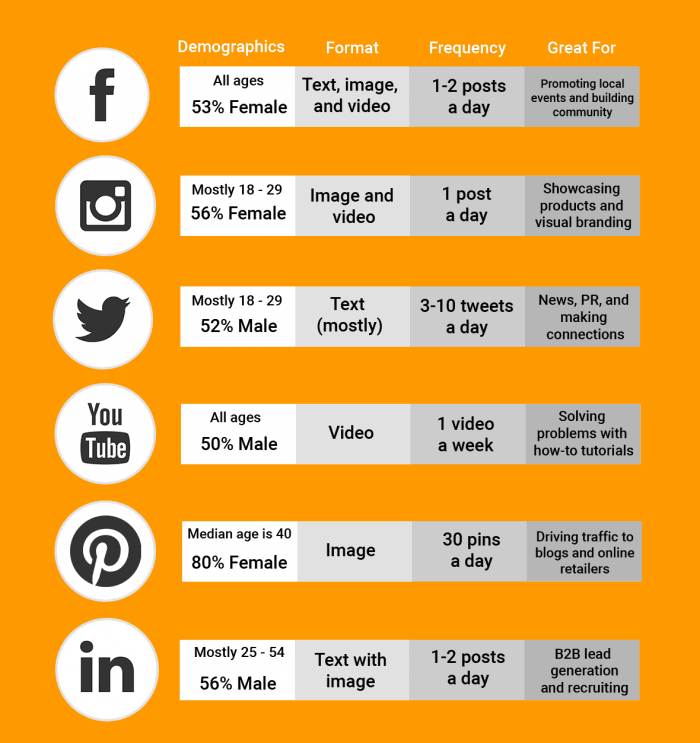
Source: Reaction.ca
3. Campaign timelines
Every social media campaign needs a definite timeline: a start date, an end date, and a publishing schedule. Without this, you won’t be able to connect your campaign to definitive results. Also, a timeline adds urgency and scarcity to whatever you offer during the campaign.
When creating a social media timeline, think about working in stages. Each stage can have its own content direction and outcomes. All of your plans can be documented on a campaign calendar. You can be more efficient by scheduling posts in advance, so you can review your content on a queued-up calendar and make any last-minute changes when needed.
4. Social media automation tools
Like a brand, running a consistent campaign is no joke. If you have time-sensitive plans, think about using a third-party tool for your publishing. There could be other features that matter to you, so it’s important to conduct some research before you decide to invest.
One example is DrumUp, a “set it and forget it” tool that can help with social media campaign management. If you decide to it, you can bulk-upload your social media posts from spreadsheets to libraries within the tool. Then, you can either custom-schedule your posts or queue up an automatic posting schedule. You can review upcoming posts in a calendar format and edit them any time before they’re published. Visit this post for a full list of social media automation tools.
5. Graphic design
Next, it’s time to create the actual content. For a coordinated campaign, you probably want to keep in mind the big picture when creating individual posts. You could begin by clarifying your core message. Once you have, you can create a “bucket of ideas” to work with for individual posts.
Keep in mind your ideal customer’s journey—how they move from awareness to conversion. You can then decide which format to create your posts in. Visuals work wonders when it comes to social media, where attention is sparse and distraction is plenty. If you aren’t sure what type of content you want to use, you could simply ask your audience, like IBM did.
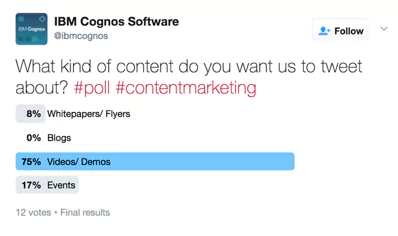
Worried about what your content will look like on different platforms? Use social media templates to make sure your graphics are on-point. Lucidpress has a whole gallery of social media templates sized to perfectly fit the platform of your choice, from Facebook and Twitter to Pinterest and Instagram. Upload your images and brand assets to your library, then edit the content with your brand colors and fonts. Creating social media graphics in Lucidpress is quick and easy, so you can have a full campaign designed in minutes.
Read more about designing social media graphics in Lucidpress here.
6. KPIs & tracking
Unless you continuously track the response to your content, you won’t have any points of reference to refine your social media marketing strategy. As people interact with your content, you can extract useful data based on their engagement. This data can prove useful in instances that aren’t related to social media marketing, such as product development and marketing on other channels.
Additionally, set KPIs alongside your goals, so you can measure your progress and assess the effectiveness of your efforts. Most social media platforms offer deep analytics, and there are third-party tools you can use to mine data. One of the tools I find useful is SimplyMeasured, because it offers several insights (in report format) for free. If you can’t log in to the tool on a regular basis, you could instruct the tool to send automated reports via email.
7. Social media management responsibility
Whether you’re a small brand with limited resources or a big brand with a large team, it pays to plan responsibilities in advance. Who will manage your social media campaign? Who will create the content, track the response, and interact with followers?
Some companies misjudge the amount of work involved in social media management. Content creation, community management, and analytics are demanding tasks that need people who can hustle, people who can stay on-point throughout the duration of the campaign. If you intend to outsource the work to an agency, you still need to track its progress. I recommend using Trello or Asana, so you can manage the review and approval process without having to waste time on calls and meetings.
8. Post schedule and cadence
The timing of your post matters a lot. It’s one of the most important factors in a particular post’s potential for engagement. To reach the highest number of people, content must be shared strategically to catch them while they’re online.
The peak times for various social media platforms are different. Conduct research to figure out the best times to post. There are tools like Facebook Insights and Followerwonk that can help you determine the right times to post.
9. Recycled content
You’ve likely noticed this: many popular pages will share the same content multiple times, continuing to earn engagement each time. Most followers will engage with the content without ever knowing that it was reposted.
It’s almost a given that your post will not reach your entire audience, so it’s not a bad idea to share the same content multiple times. However, do take time to review and make adjustments to the headline, description and image before sharing the content again.
10. Headlines and copy
People will read your headline before they decide whether to read the rest of your content. Your headline must be compelling enough to grab readers’ attention. It should contain a promise of value, information, or entertainment. Don’t forget, you’re competing with hundreds of posts from a variety of sources, so you’ve got to offer something exceptional.
Give yourself a leg up by testing your headlines. Don’t limit yourself to just one; instead, create multiple headlines and conduct A/B testing to see which one performs best. Then implement the winner across your campaign to boost your performance.
Not sure where to begin? Tools like Buzzsumo can help you research and discover high-performing social media posts.
11. Paid promotion
A little bit of advertising can go a long way. Most of the social media networks have a walled garden of advertising opportunities (as in they offer paid ad opportunities specific to that platform), which is great for anyone starting out with paid promotion. The key to ensuring a successful paid promotion initiative (and to refrain from wasting your budget) is to target specific audiences on specific platforms. So, place business ads for professionals on LinkedIn, or toss-up some self-serve ads on Instagram for Millennials. To dive a little deeper, we recommend checking out comprehensive article on social media advertising.
Ideas on developing your social media strategy
Want to kick butt and go viral on social media? Well you’ll need to establish a strategy. Here’s our recommendations as to how you can get started.
Research your competitors
Know thy enemy. Or something like it. Listen, you need to know who you’re up against (and why) — including what they’re doing well and what they’re totally dropping the ball on. So do some research. Create a shortlist, replete with similarities and differences. From there you’ll be able to plan how, where, when and why you’ll overthrow said competitor. Or you could just challenge them to a dance-off and see who wins.
Identify your content topics
Tempting as it might be to throw caution to the wind and just post whatever content comes to mind, we’d venture to say that you shouldn’t. Identifying content topics well ahead of time (and thus creating a content schedule) empowers you to use your time effectively and change gears should you discover that something’s not as effective as you’d like it to be. Plus, identifying content topics preemptively means you can bring more friends into the fold and ask for their assistance with visuals, copy and more. After all, no one likes being told “Hey I need your help but I’m not sure with what.”
Establish a visual identity and voice
Tragic as this might sound, recognition by association is what differentiates winners from losers. In other words, you want people to know who you are as it creates a winning environment. Therefore, by establishing a visual identity and voice, you create a foundation for recognition and success.
If you’ve been following Nest, you know they’re not your average home electronics company. Just check out the cool gadgets they make, and you’ll know what we mean, like:

Nest Learning Thermostat
Or this:

Nest Protect, a smoke & CO detector
But not only is Nest changing the home automation game, they’re also aces at marketing.
Recently, we had the chance to speak with the social media director at Nest to get the inside scoop on what makes for a successful social media marketing strategy.
Build a community
The first thing we learned is that Nest prioritizes community building. They do this by putting out a steady stream of social content that provides value for their customers. They’re also quick to retweet their customers’ content or respond to a comment by a customer who’s experiencing a problem.
Instead of thinking about what your business can gain from social media, think about what you can give. You could use social media to post helpful tips and friendly advice for your customers. This helps them get the most out of your product, and it builds the value of your brand. Here’s an example of this kind of post from Nest:
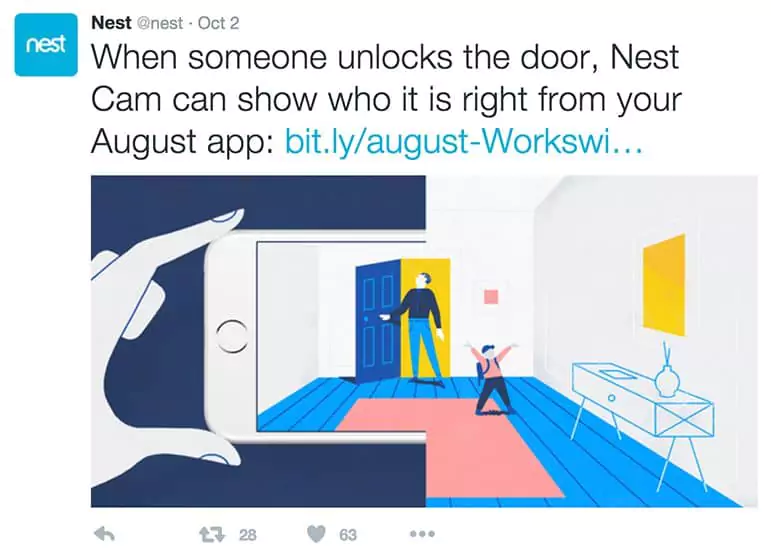
The more your approach to social media feels like a natural interaction between friends, the more success you’re likely to have. You want to build a community where customers share things they love with you, and you share things you love with your customers.
For example, Nest’s customers often mention them in tweets talking about how much they love using Nest’s products. Here’s one such tweet:
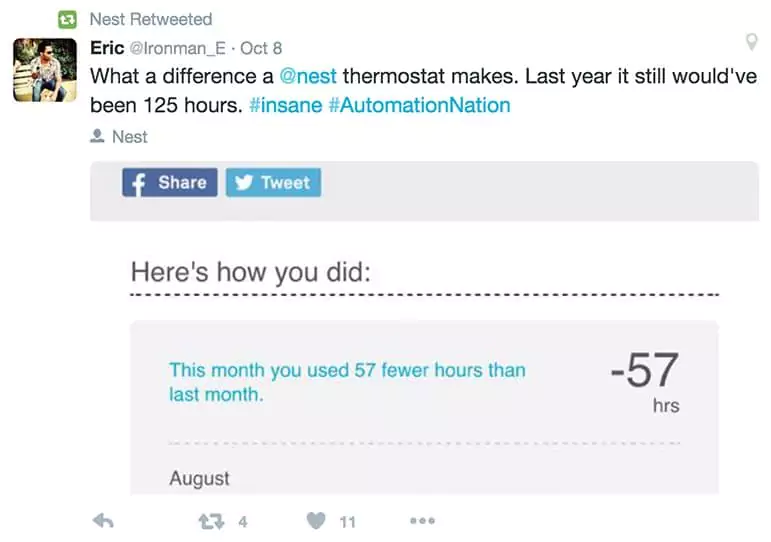
Happy customers give you free marketing and become your greatest assets.
Likewise, Nest is quick to share things they’re excited about, like this post that showcases a work of art a Nest user made to enhance their wall-mounted Nest thermostat:

A marketer’s dream: customers seeing your product as a work of art.
This is the zone where you want to be with your social media efforts. But how can you get there? You need to start by becoming familiar with your customers. This leads us to the next lesson from Nest, which is…
Use customer insights to inform your social media strategy
This is a simple principle, but that doesn’t mean it comes easily. To be personal and relatable to its customers, Nest needs to know them really well, and they’ve clearly invested the time to do so. You can’t help someone see how your product will contribute to the things they care most about without knowing what those things are.
Your customers and community should be the main consideration in your social efforts.
Nest has mastered the strategy of observing how their community is interacting and engaging with their social channels, then producing content that speaks to those interests.
What does this look like in action? One of Nest’s principal products is a smoke & carbon monoxide detector called Nest Protect. They recognize that their customers care about safety, and in response to that, they promoted a campaign to nominate local fire departments for a grant.

If you’re a local brand, consider looking for community causes you can get behind, then supporting them in a social campaign. It’s a great thing to do for your community, and it can help you gain some social media traction as well. Just make sure you’re sincere in whatever you do.
Additionally, all of Nest’s branding and content have a personal feel that gets to the core of what a good connection between the customer and company looks like. One of my favorite things that Nest does on social media is the Caught on Nest Cam video series, which consists of clips of funny or interesting moments captured by Nest Cams in the homes of actual customers. Here’s a good one:
With this social media effort and many others on Nest’s pages, they are using a technique perhaps best exemplified by one of my all-time favorite marketers: Apple. Though Apple is a huge company, they’ve managed to maintain a personal feel in their branding, and they often focus on the human element of their products.
Apple’s marketing shows their products integrating seamlessly into everyday life and enhancing the things that people care most about. Nest does the same thing by showing their products in people’s homes and providing the safety, peace of mind, and convenience that their customers crave. A recent ad by Nest did a great job of capturing the human element. It depicts a house as a speaking character talking about his experiences with the family.
Your business can do this, too. Think about the basic ideas behind why you started your business. What value does it add? How does it make people’s lives better? If you can answer these questions, then it’s just a matter of telling people about it.
If you own a sandwich shop and you think your food tastes the best and will make people happy, then post a photo of happy people eating at your shop, or your food bringing people together at a party. When you focus on your customers, your ideal strategy will become clear.
Customize the content for the platform
It’s not an easy task to customize your content for each social media platform, but if you’re serious about social media success, it’s a necessary investment. You should optimize the headlines, images, descriptions, and even your tone of voice to match the platform you’re posting on.
The same content that performs well on Facebook isn’t guaranteed to perform well on other networks. For instance, Twitter has a character limit. Instagram only supports certain image sizes. The tone you would use on LinkedIn is likely quite different from the one you’d use on Snapchat.
This is another good reason to limit how many social media platforms you choose. By focusing on the most important ones for your audience, you’ll have more time to craft content that feels native and authentic to the platform.
Embrace the visual
A recent study showed that visual content is 40% more likely to be shared than plain text content. And as you know, more shares lead to better reach and higher engagement.
Try to create attractive, eye-catching images not just for your brand’s profile but also for every single post. Try experimenting with different types of visual content such as infographics, memes, and so on.
In the case of image-sharing social media platforms such as Pinterest, Instagram and Snapchat, posts with poor visuals have no hope of attracting attention or engagement.
Ask questions
A great way to engage your followers is to ask questions relevant to them. Everyone wants to share their opinion, and the comment section is a good place for you to connect and interact with your fans. It helps your brand feel more human and build more personal connections.
There are plenty of creative ways to ask questions to your followers. Create a poll, a quiz, a would-you-rather, or a trivia question to stimulate conversation. Make sure someone is watching the discussion to keep it focused and productive—and to remove inappropriate comments if necessary.
Reach out to influencers
According to this study, an average return on investment for an influencer marketing campaign is $6.50 for every dollar spent. This speaks to the power of influencers and influencer marketing.
There are hundreds of influencers on social media platforms today, and each of them has curated a unique audience. Contrary to popular belief, you don’t have to find influencers with millions of followers to be effective. You’ll probably find that the best results come from partnering with influencers who share an audience similar to your own, so dig into your niche and make a shortlist.
Wrapping up
Finally, it’s important to consider roadblocks in advance. Social media is a constantly changing landscape, so be prepared to forecast and preempt potential disasters. Check whether the dates you’ve selected clash with any meaningful holidays, and consider whether your content has the potential to bump into sensitive issues. By considering this in advance, you can set yourself up for success.
Ready to make your own social media posts? These free social media templates are a great starting point.
You’ve probably heard of the term “employee engagement” by now, but have you heard of employee experience? As more and more companies shift towards customer-centric goals and healthy work environments, we’re seeing an overall prioritization of the employee experience. And for a good reason too.
A great employee experience can lead to some pretty stellar success for your company. But what’s the point in building a great employee experience?
What is employee experience?
First off, just what is employee experience?
Well, employee experience is everything an employee experiences at work, which can be anything from software to interactions with you or their teams. It’s a general term that encapsulates the full spectrum of an employee’s experience throughout their time with your organization.
But don’t confuse employee experience with employee engagement. Employee engagement is a focus on rewards and perks. It’s a booster shot businesses use to jump-start their beating heart. It can include recognition programs, a different floor layout, monetary rewards, etc.
Employee engagement is more of a stepping-off point. It’s good when you first initiate it, but you need to have something more concrete to continue the momentum forward — which is where employee experience comes into play.
As the name suggests, the employee experience is a movement all about creating workspace practices that fit your people. So, instead of trying to make square pegs fit into round holes, you change the holes to fit the pegs, which we’re aware sounds likely overwhelming and heady.
Let’s keep moving.
Why employee experience matters
Cool, cool, cool. So what, why does it matter?
Your employees want to be valued as human beings — not just valued for what they offer the company. If you’ve received employee feedback along the lines of ‘I don’t know how my work impacts ROI’ or ‘I don’t feel heard or appreciated,’ then your org could stand to benefit from a revamped employee experience.
In a study by Deloitte University Press, researchers found nearly 80% of execs worldwide rated employee experience as necessary or very important. On top of that, experiential organizations have seen four times higher average profits with 40% lower turnover. This isn’t surprising when you think about how a great employee experience lends happier, more engaged and efficient workers.
Additionally, organizations that invest in employee experience can be found almost four and a half times as often on LinkedIn’s list of North America’s Most In-Demand Employers and are 11.5 times more likely to be found in Glassdoor’s Best Places to Work.
If that doesn’t convince you, consider these employee engagement stats:
- Organizations with great employee experiences achieve a 10% increase in customer ratings
- Businesses see far fewer safety incidents (70%)
- Happy employees are 4.6 times more likely to perform their best work
Stages of the employee experience
The employee experience begins when someone steps in the door, all the way to when they leave your company.
In total, there are five stages of the employee experience:
Recruitment
This includes every step involved in identifying, attracting, screening, interviewing and hiring a new employee. As you work toward improving the recruitment process, consider: how long does it take to hire, how much does it cost (to hire), what is the rate of offer acceptance and the hire’s quality? Is the interview process engaging? Do your job ads attract the best talent? Evaluate current effectiveness and unpack what you could do better.
Onboarding
The onboarding, or training stage, is where your new hires get up to speed with your tools, processes and systems. The quicker a new employee can get up to speed, the sooner they can get the ball rolling. You’ll know if your onboarding process is effective by whether or not a new hire’s initial enthusiasm translates into a more meaningful, long-term connection to the company.
Development
Development is the ongoing stage in your employees’ journeys. Everyone will develop at different rates, but you need to quantify their productivity, promotion aspirations, and ability to be a team player as they grow. Offer them a chance to expand their skillset.
Retention
At this point in the journey, your employees are fully integrated into your organization. Now, the challenge is how to keep them performing and contributing to the organization’s success. It can often cost upwards of $35k to replace an employee, so finding ways to ensure yours are inspired and connected can save you a lot of cash.
Exit
Whether your employees leave due to retirement, move to a new employer, or have a life change, you need to understand what drives the transition. Doing so can help you improve and develop the employee experience.
How to improve the employee experience
Make it count
Changing the employee experience requires a holistic approach — it’s a change that has to happen at the core. You need to be empathetic and thoughtful in your interactions with your employees. Treat them like customers. It’s easy to look at the customer experience and see what you do there and mirror it to what you want to do for your employee experiences.
Co-create solutions
Affecting change in the workplace requires help from HR. It’s a chance for HR to bring both employees and leaders to the table to improve the employee experience. Sit downs like this help streamline testing needs and socialization efforts, allowing for things to move from concept to execution quicker when both leaders and employees are involved in finding a solution.
Refine the creative process
Find pain points in the creative process and eliminate them. By making these changes, teams can prioritize time for the most meaningful work. For example, we recommend creating a system of checks and balances using content creation software. By doing so, you empower employees to make personalized adjustments to creative content while ensuring your creative team can continue to focus on meaningful projects instead of making small edits all day. Templates can come in handy to keep things on-brand, so you don’t have to worry about significant changes (or typos) happening to content before it gets shipped out to clients.
Use the right tools and technology
Good tech helps streamline otherwise complicated (or dysfunctional) processes and improve employee engagement. With the right tools, your employees can effectively get their job done — minus a lot of frustration.
Ways to measure the employee experience
As with any changes you make to your work processes, it’s important to measure employee experience to ensure these changes work. You can do this in several ways, such as:
- Pulse surveys
- Exit interviews
- Open feedback platforms
- Candidate interviews
- Engagement surveys
- Performance conversations
Knowing what your employees feel at various stages of their growth and employment with your company can help you improve not just their experience but your org’s overall success. Disgruntled or unhappy employees could cause some significant setbacks.
As you begin to turn your focus inward and find ways to understand your employees’ needs better, you’ll start to see a unity within your company that you may not have seen before.
If you want to find out more about the impact of employee experience on customer experience, check our ebook on CX failure.
When Instagram rolled out 24-hour Stories back in 2016, it became a sensation overnight. Almost eight years later, the feature is still going strong, and many marketing teams have made it a fun part of their social media strategy. But there’s an art to this seemingly simple feature – and simply posting and hoping for the best isn’t it. If you want to use Stories strategically, you’ll need to delve into your target audience and figure out your brand’s visual identity.
In this quick guide, we’ll walk you through how to use Instagram Stories strategically, with some great examples to give you a head start.
What are Instagram story filters?
Of Instagram’s more than 2 billion users, 500 million of them watch at least one Story per day. And while overall Story reach rate has declined over the past few years, they’re still an incredibly sticky feature, with a full half of Instagram users reporting that they’ve visited a brand’s website to check out or buy a product after seeing it on Stories.
By these stats alone, it’s abundantly clear just how powerful Instagram Stories are for brands large and small. But numbers aside, there are several strategic reasons to have a solid Instagram Stories plan in place, including:
- Instagram Stories humanize your brand: Unlike our highly curated feeds, Instagram Stories are meant to be ephemeral (they only last 24 hours), timely, and authentic. They’re the perfect medium to showcase the real people, stories, and values behind your brand.
- Stories are much harder to miss: While the IG algorithm used to show posts in your feed in the order they were posted, that’s no longer the case. That means that your shiny new posts might not actually be seen by some of your audience. But when you post a Story, your followers will see it above their feed, and might even get a notification about it.
- You can share links: One of the biggest complaints marketers have about Instagram is that you can’t share links in regular posts. Thankfully, if you have a business or creator account, you can share clickable links in your Stories, making it much easier for your followers to check out your website.
- More opportunities for engagement: Other than commenting or liking, there isn’t too much a person can do with a regular in-feed post. But with Stories, users can respond to polls, share direct messages, ask questions, and more.
Tips on how to use Instagram Stories
Want to make the most of your Instagram Stories strategy? Here are a few tried-and-true tips:
Create a consistent visual identity
If one of your followers randomly stumbled upon your Story without any context, would they know it was from your brand? If the answer is ‘no’, then it might be time to rethink how you’re approaching your brand’s visuals. Brand consistency is key to making your content recognizable, memorable, and most importantly, effective.
So what does this mean in practice? We’d recommend starting by using the same color palette, fonts, and imagery you use in other branded materials. For example, if your website uses a lot of plant and nature imagery, your Stories should as well.
Post often
Like with any social media strategy, it takes time to see the fruits of your efforts. Don’t get discouraged and quit cold-turkey if you don’t see a lot of results after just a few weeks or months. Posting great content on a consistent schedule is essential to building up a dedicated audience over time. Research shows that around 2 stories per day is the ideal, but feel free to experiment and see what works best for your brand.
Avoid too many frames
No one likes the person who spams posts on their IG feed, and the same goes for Stories. According to Rival IQ, the number of people who stick around to watch your Stories drops off below 75% after 7 frames.
Experiment with storytelling
Storytelling is one of the most powerful tools you can use as a brand. And when it comes to IG Stories, narrative-based content wins, with 35% of users preferring short narratives.
A few ideas here:
- Walking users through a how-to or tutorial
- Sharing your brand story
- Taking your audience on a ‘day-in-the-life’ of one of your employees
- Showcasing stories from your customers
Use CTAs
Just like with any other type of social media post, your Instagram Stories should point people in the direction you want them to go. A call-to-action, like a clickable link or interactive poll, incentivizes people to engage with your Story and account.
Some of our favorite Instagram Story examples
Outdoor product Instagram story template
Got a seasonal launch or sale coming up? This customizable Instagram Story template offers an eye-catching way to detail several different products at once.

America’s Test Kitchen
If you want people to engage with your brand, ask them their opinion! This simple Instagram Story from America’s Test Kitchen is a great example of how to easily boost engagement, all while subtly driving people to your website for more.

Work from home Instagram Story Template
Customizable bingo is another fun way to gamify your content and get people interacting with you. Choose an on-brand bingo theme and invite people to screenshot and tag you in their own Story. If someone gets bingo, repost it back to your Stories!
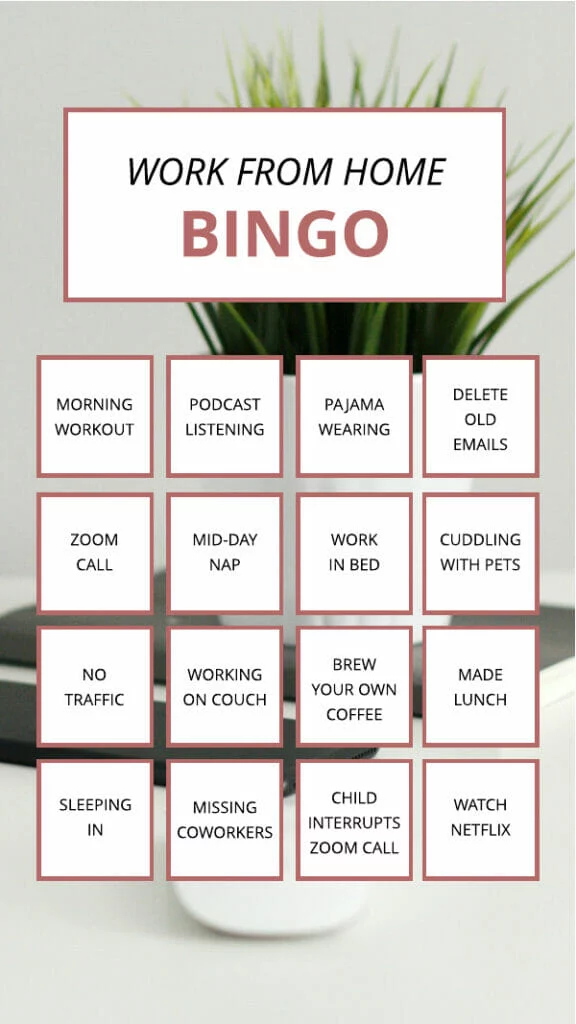
Nike
We love what Nike did here with their short-form video IG Story series. They sat down with some of their athletes for a short look into their career accomplishments – and didn’t mention any of Nike’s products. It’s a masterclass example of using compelling storytelling to your advantage. Not everything you post has to tie back to your product or service, but it should reinforce your brand and what it stands for.

With Instagram Stories, the possibilities are pretty much endless. Not sure where to start? Check out Marq’s free template library full of customizable Instagram Story templates and get creating!
Life comes at you fast, and social media trends are no exception. Time spent online has ballooned in the last year, with social media increasingly being used to satisfy needs from creating community to e-commerce. This social media trend has shifted power into platforms like Facebook and Instagram, where consumers now spend a huge chunk of their day.
So how do you grab the attention of that captive audience and harness it for your small business? Here are nine social media trends to boost engagement, attract followers and elevate your brand.
Grow brand influence with these 9 social media trends
Already know the lay of the land? Dig into creating branded social media content with our free social media templates.
1. Social selling is the future of e-commerce
Social selling, or the integration of e-commerce into social media platforms, is thriving. Product tags and shoppable posts are making it easier than ever for small businesses to not only connect with customers but convert them.
These seamless social media shopping experiences reduce friction in the customer journey by offering options to purchase products without leaving the platform. With online retail up nearly 30% in both the UK and the US, social selling has the potential to transform online sales.
2. Harness the power of micro-influencers
One long-standing social media trend is influencers. These powerful brand ambassadors have the ability to make or break a product launch and can be a better investment than advertising to get more visibility for your brand.
If your budget isn’t likely to support a shout-out from a Kardashian, never fear. Micro-influencers are effective in niche markets and far more affordable. These influencers have smaller spheres of influence but up to seven times more engagement with followers than larger accounts.
3. Focus on video content
From Instagram Reels to TikTok, the dominance of video content is here to stay. A study from Cisco indicates by next year, 82% of global internet traffic will come from video streaming and downloads. Whether it’s user-generated shorts or long-form YouTube, video content is king for generating engagement.
Social media trends like video don’t have to be a big investment. You can start small by livestreaming or doing quick tutorials. Many brands also get extra mileage by editing and recycling clips to create fresh video content.
4. Pay attention to private social media communities
Engaging your customers in the comments is an excellent first step, but there are benefits to social trends like connecting with private groups on social media. These collections of users with shared interests can blossom into robust communities that support your business goals.
For instance, Facebook groups for wandering nomads are a powerful place to get feedback on travel services or amplify products like luggage. On Instagram, you’ll find like-minded communities gather in shared hashtags such as #Eeeeeats or #GirlsWhoTravel.
5. Get real with social listening
Increasingly, social media audiences are less interested in what you’re promoting and more invested in having meaningful conversations. Once you frame social media channels as a way to connect with customers and build community, sales inevitably follow.
Fortunately, the key to nourishing social media conversations is straightforward. Listen. Find opportunities for your followers to give feedback and ask questions. Create an authentic social media presence by committing to transparency, owning up to mistakes and apologizing. Having those hard conversations in the public eye shows your brand cares.
6. Try livestreaming
If you associate livestreaming with gaming, you’ve got some catching up to do. Livestreaming dominates social media as a way to connect with followers in real-time and gain a wider audience. Going live on Facebook or Instagram was once a novelty but is now the norm for both casual users and businesses.
Because much of our daily lives have shifted online, livestreaming is a way to hold events virtually, from pet adoptions to open houses. Streaming gives your audience a behind-the-scenes peek into your work and helps them feel more invested in what you do and who you are.
7. Combat the rise of disinformation
Social media isn’t all roses, and the rise of disinformation on many platforms has proven it. The good news is brands can become part of the solution. Taking responsibility to correct misinformation within your industry earns you karma points and loyal followers who will amplify your stuff.
However, proceeding with caution when promoting social media trends like this is paramount. Even small missteps can generate embarrassing attention online, so double-check your facts before posting.
8. Invest in socially conscious content
As brands have discovered recently, the line between personal choices, politics and public policy can become blurred. Using your social media channels to amplify socially responsible messaging communicates the kind of support for the community that can be a brand booster.
According to 5W Public Relation’s 2020 Consumer Culture Report, 83% of millennials and younger consumers want to support companies that align with their values. Given that forecast, social media trends like social action campaigns are here to stay.
9. Get more out of your metrics
Much to the frustration of social media marketers, metrics used to boil down to conversion. That focus is shifting as more brands recognize the power of social media translates to more than sales. Measures of success are widening to include not just how followers engage but also the reach of social media content.
Here are few metrics to consider for your social media marketing plan:
- Brand awareness (post reach, mentions and impressions)
- Engagement (amplification rate, applause factors)
- Customer satisfaction (testimonials, review scores)
Social media platforms like Instagram and Facebook still offer metrics on conversion like click-through rate (CTR) and cost-per-click (CPC). But some of the newest metrics seek to capture customers whose interest lands higher up in the sales funnel.
Staying on top of social media trends helps your business adapt and thrive online, but it’s also important to cover the basics of a well-branded social media presence. Lucidpress can help. Get started and try our free social media templates.
Instagram is one of the fastest-growing social media platforms, with over one billion monthly users spending up to an hour a day perusing the app’s vibrant, visual content. Home to the influencer and brand ambassador, Instagram allows powerful companies and small businesses alike to level the playing field and connect with prospective customers.
Instagram says 90% of its users follow at least one business account, and two in three Instagram users confirm the app drives their interactions with brands. While you might not be Nike with 133 million followers, Instagram can still be a lucrative space for small businesses to leverage.
Why small businesses should use Instagram for business
Instagram business usage has exploded in the last few years among brands that realize the platform’s potential to reach younger audiences. With dynamic video and lifestyle content, Instagram is an ideal space for marketing campaigns, product launches and brand building.
Because this social media community has a mobile-first approach, it can seem intimidating to small businesses. But if you’ve been lukewarm about launching a business account, now is the time to establish your Instagram presence and take advantage of the exposure this popular platform provides.
How to set up your Instagram business account
If you’ve been tinkering with a semi-official personal account, take the plunge and switch your profile to a business account. If you don’t have an Instagram presence yet, create a personal account first, then switch it over to a business profile.
Confused about how to get started? Pop over to Instagram for Business and get the official Guide to Getting Started for detailed instructions and more information.
Instagram doesn’t allow much to be packed into your profile, so make sure your bio is succinct with contact information such as your company’s website. Think carefully about including branding elements in your profile pic to make your business stand out in a sea of selfies and carefully staged photos.
Learn more about types of Instagram content
Once you’ve got a profile established, it’s time to populate it with content. Just remember that not all eye candy is created equal. The kind of content you choose to invest in may differ depending on your business goals. Here are the basic types of content available on Instagram.
Instagram Posts
Because Instagram is a visually driven platform, every post begins with a photo or video. While you’ll have plenty of space to caption the image and include details, the picture is the focal point of every good Instagram post.
But fantastic photography isn’t going to distinguish your business profile from all the visual noise on Instagram. Instead, engage your audience through diversifying your Instagram posts and content. Need some inspiration? Lucidpress has some Instagram post ideas proven to boost sales.
Instagram Stories
This Instagram feature splices together video and photos into a story that expires in 24 hours. Creator-generated filters for Instagram stories use AR and other effects to layer over your content for a signature Instagram experience.
New to Instagram stories and need a little hand-holding until you get the hang of it? Lucidpress has Instagram story templates to get you started.
Instagram Reels
For users who dig TikTok, Instagram Reels provides a similar approach with short videos you can share. Overlaid with filters, music and other effects, Reels is a handy way for brands and small businesses to showcase products and share behind-the-scenes footage.
IGTV
You guessed it. IGTV stands for Instagram TV. It’s a channel dedicated to promoting longer videos of up to 10 minutes. Bonus points if you’ve got a verified account because you’ll get the perk of posting 60-minute videos. Businesses use IGTV for tutorials, Q&A sessions, and customer success stories.
Instagram Shops
While all of this brand-building content is a plus, you need a way to monetize and convert traffic from your business social media accounts. That’s where Instagram Shops comes in with a shopping experience that works seamlessly with Instagram and helps convert followers into customers.
Use these Instagram engagement strategies to boost your business profile
Boost your Instagram engagement, grow your following and expand the reach of your content with the following strategies.
Leverage hashtags
The best way to make a splash on Instagram is to ride the wave of trending topics. Instagram’s search feature is driven by hashtags, so tagging all your content with relevant hashtags is an easy way to increase reach.
While you can use up to 30 hashtags per post, more isn’t always better. On Instagram, you’ll get more traction from hashtags that are trending. Avoid randomly throwing in trendy topics that don’t apply to your content, though, or you’ll risk seeming spammy.
Sponsor contests and giveaways
Who doesn’t love free stuff? Instagram is a great place to promote giveaways that’ll garner attention and shares. And while you should take engagement on these tantalizing promotions with a grain of salt, it’s still an excellent opportunity to find new followers and recruit lifelong customers.
The most successful giveaways and contests on Instagram have a few things in common. First, they run for a short period of time and provide exclusive products or content for those who participate. Secondly, using branded visual elements and customized hashtags boosts shares and organically expands the reach of your promotion.
Encourage collaborations
Influencers and brand ambassadors with large followings make a legitimate living on Instagram by amplifying products and campaigns they care about. You can leverage that influence for your small business, but successful collaborations come with some caveats.
It’s vital to do research and connect with an influencer who has some “social proof” or credibility in your industry. While a Hollywood celebrity account reaches millions, those fans may not be the best market for your product or brand. You also don’t have to spend a hefty chunk of change to make successful collaborations or sponsor a post. There are plenty of influencers who have fewer followers but work with niche audiences that could be a great fit for your Instagram business.
Create valuable content
Whether you use Instagram for business or personal reasons, there’s a simple rule to gaining followers. Create high-quality content that people care about. Instagram has a strong level of user engagement, so figure out what your audience wants and deliver it consistently. From how-to videos to deep-dive infographics, don’t hesitate to explore the passion behind your product or brand.
Another way to make sure your business is creating valuable content is to ask yourself if what you’re sharing on Instagram builds community. While some accounts might chase clout, ultimately the brands that have high levels of engagement are those that have built trust with followers.
Write compelling captions
Instagram is visually-driven, but captions are your last and best chance to communicate with your customers. Write compelling captions with these simple rules.
- Start with a good hook. Instagram makes you click to read past the first 125 characters, so make sure people want to read on.
- Place keywords at the beginning to capture attention.
- Get expressive with emojis.
- Sneak in trending hashtags at the end.
- Don’t forget a CTA or a question to boost engagement.
Maintain visual and voice consistency
Before rolling out the red carpet on your brand new Instagram presence, think carefully about your brand voice and values. How can you communicate what you care about through the visuals on your Instagram business profile?
Whether you’ve decided to keep it consistent with a certain color palette or using humor and wordplay to show off your products, you can keep your Instagram vibe consistent with Lucidpress Instagram post templates.
Measure results
Using Instagram for business puts a wealth of data at your fingertips to measure engagement on your posts and tweak campaigns to produce better results. The reporting tools aggregate data into a single dashboard, so you can glean insights at a glance. You’ll see overall stats for your business profile, and you’ll also be able to drill into post engagement to find the best performing hashtags and content. Learn more about how to use Instagram insights for your business over at Facebook’s Business Center.
How to use Instagram ads
Advertising on Instagram is relatively cost-effective and accessible for small businesses. If you already have a Facebook advertising account for your business, Instagram for business will look familiar since it runs on the same platform. In some cases, you can cross-promote campaigns or content across both Facebook and Instagram.
Before you dial in the details of your Instagram ad campaign, make sure you’ve articulated your goals. Whether it’s to increase followers or convert customers, your objectives will determine factors like ad placement, targeted audience, budget, schedule and the ad format. You can learn more about how to create effective Instagram ad campaigns at the Instagram for Business center.
Designing a dynamic Instagram presence for your small business won’t happen overnight, but if you commit to creating high-quality content, you’ll convert casual followers into lifelong customers for your small business.
Get started elevating your Instagram profile with Lucidpress’s Instagram templates.